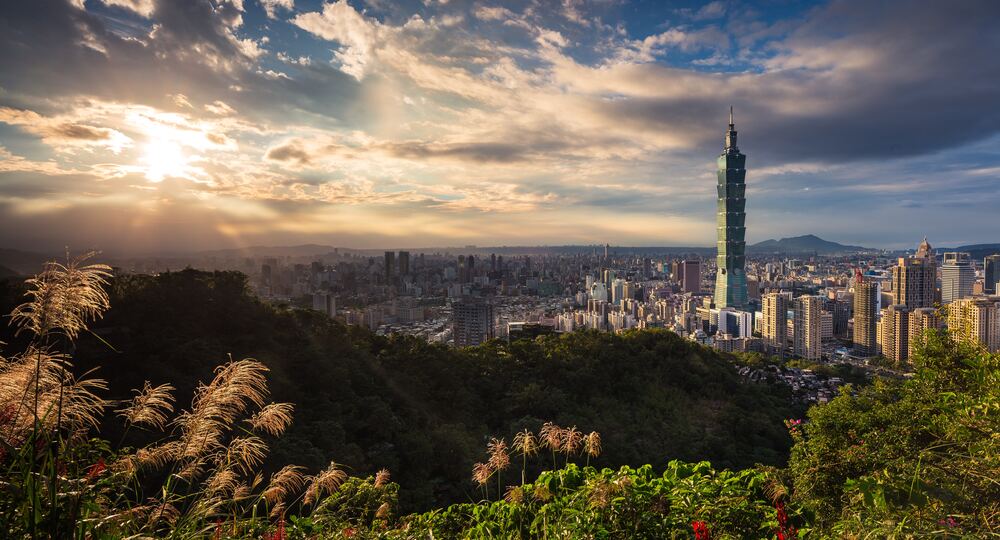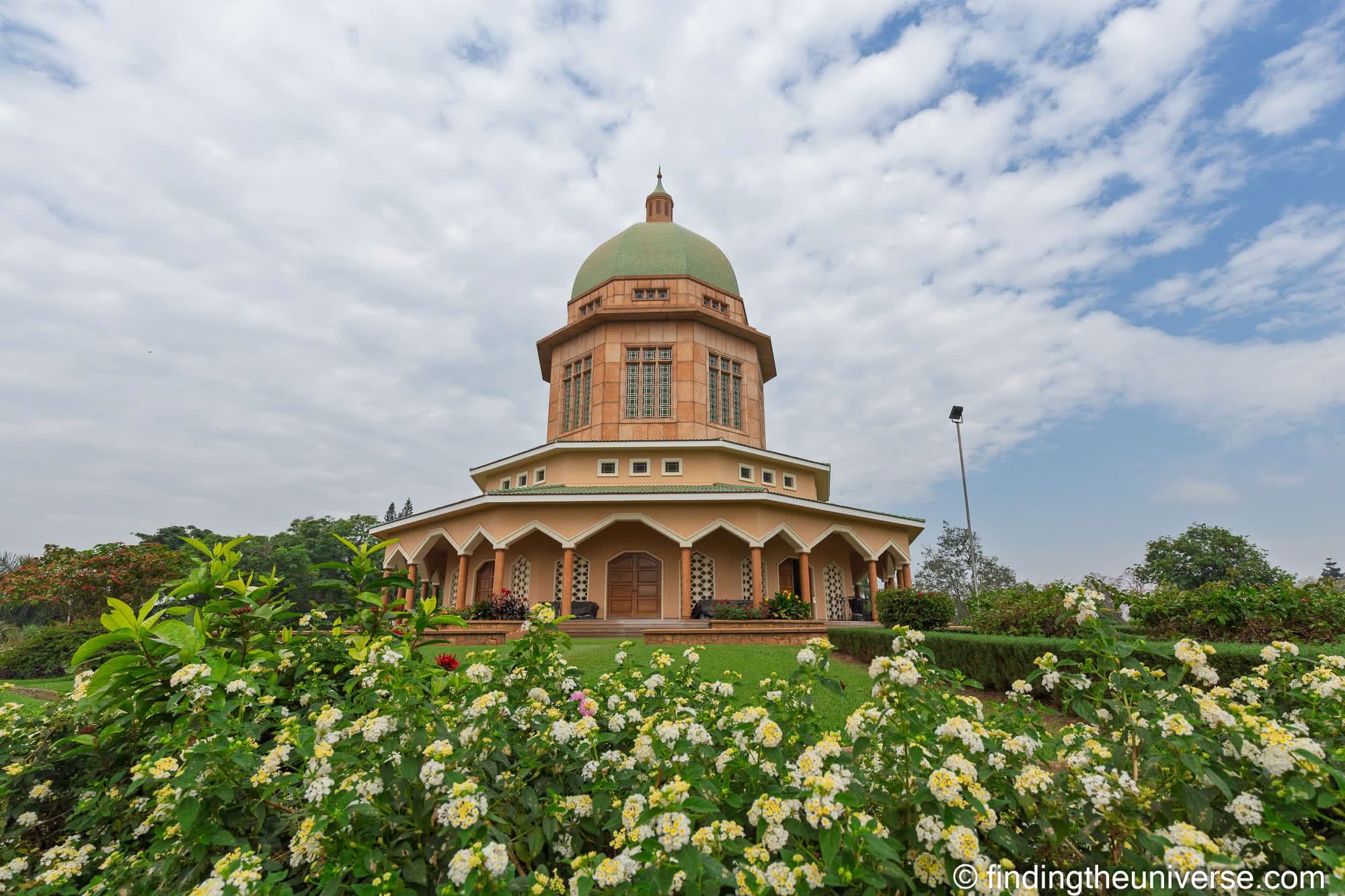
We’ve had the pleasure of visiting Uganda a number of times and had some amazing experiences including gorilla trekking and chimpanzee trekking. However, there is lots more to do in Uganda beyond those iconic activities!
When we visit Uganda, we always spend some of our time in its capital city, Kampala. This is by far the largest city in Uganda, and you’ll find lots of things to do in Kampala, including cultural sights, museums, markets, and more.
We’ve already written about things to do in Entebbe, which is the town closest to the international airport. That is found on the shores of Lake Victoria and is also worth visiting. However, we think no visit to Uganda is complete without spending a little bit of time in Kampala.
Yes, it’s chaotic, crowded, and the traffic can make getting around a bit of a challenge. But it is the capital city, the country’s most populous city, and really the only place in Uganda where you are likely to see city life. It’s a place many Ugandans come for business, schooling, training, shopping, and religious gatherings. It also has a number of tourist attractions!
Most international travelers to Uganda spend very little, if any, time in the country’s capital, and we think that Kampala deserves a stop on your itinerary if you want to get a better understanding of the country and its people. So, if you have the time, we recommend at least a day here before zipping off to visit the national parks and to go trekking for chimps and gorillas.
Jess and I have been in Kampala four times, most times just a day or two, but on one trip we spent several days exploring the city. So, we are lucky to have visited most of the places that would be of interest to international travelers and want to encourage more people to take the time to stop and give the city a look.
In this guide, we’re going to share some of our favorite things to do in Kampala. Whether you just spend a day seeing some of the highlights as part of a longer tour in Uganda or are in town for a longer period of time, we hope this guide inspires you to see as much as you can.
We’ll also share some tips on things like getting around as well as staying safe and where to stay. Let’s get started!
Things to do in Kampala Uganda
Here’s our overview of our favorite things to do in Kampala, based on our personal experience visiting. You should be able to do all these activities across a few days or pick out your favorites for a full day of sightseeing!
Kasubi Tombs
Before Uganda became a British Protectorate in the late 19th century, the region it occupies today was comprised of a series of smaller kingdoms.
The largest of these kingdoms was the Buganda kingdom, home to the Baganda people. The Baganda are ruled over by Kings, known as the Kabaka, in a tradition that dates to the early fourteenth century, and which continues to this day.
The Kabaka are obviously very important to the Baganda people, a fact which is particularly apparent at the Kasubi Tombs, found on Kasubi Hill in Kampala.
This is the final resting place of four of the Buganda Kabakas. It is a major historical, cultural, and spiritual site in Uganda. It’s also the only UNESCO world heritage site in Kampala and remains an important spiritual place for the Baganda.
The site, which takes up 64 acres of land, dates from 1882. The primary attraction is the huge conical thatched building which houses the tombs themselves, which is often referred to as the Muzibu-Azaala-Mpanga. Because of its size the building is considered a grand example of a building using traditional methods and natural materials such as wooden poles, spear grass, reeds, and wattle.
Also on site are a gatehouse, a drum house, and cemeteries where the children, wives, and other relatives of the kings are buried. The area also has a number of traditionally constructed homes where the widows of the former Kings live and tend the graves.
The Kasubi tombs were actually almost entirely destroyed by fire in 2010, however a major renovation project was launched and they reopened in 2025. We visited as they were in the process of rebuilding and there was a number of craftsman from various parts of Uganda working.
We really enjoyed our visit to the Kasubi tombs and can highly recommend placing this on your to-do list in Kampala. This is an important spiritual site so be sure to dress conservatively. Women will need to cover their legs with a long skirt or tie a large scarf around their waist to visit. Jess had on pants but was still asked to tie a long skirt around her waist to enter.
There is an entry fee to visit, payable on site. You will be accompanied by an on-site guide for your visit. It can also be visited as part of a guided tour like this one or this one which includes several stops in Kampala.
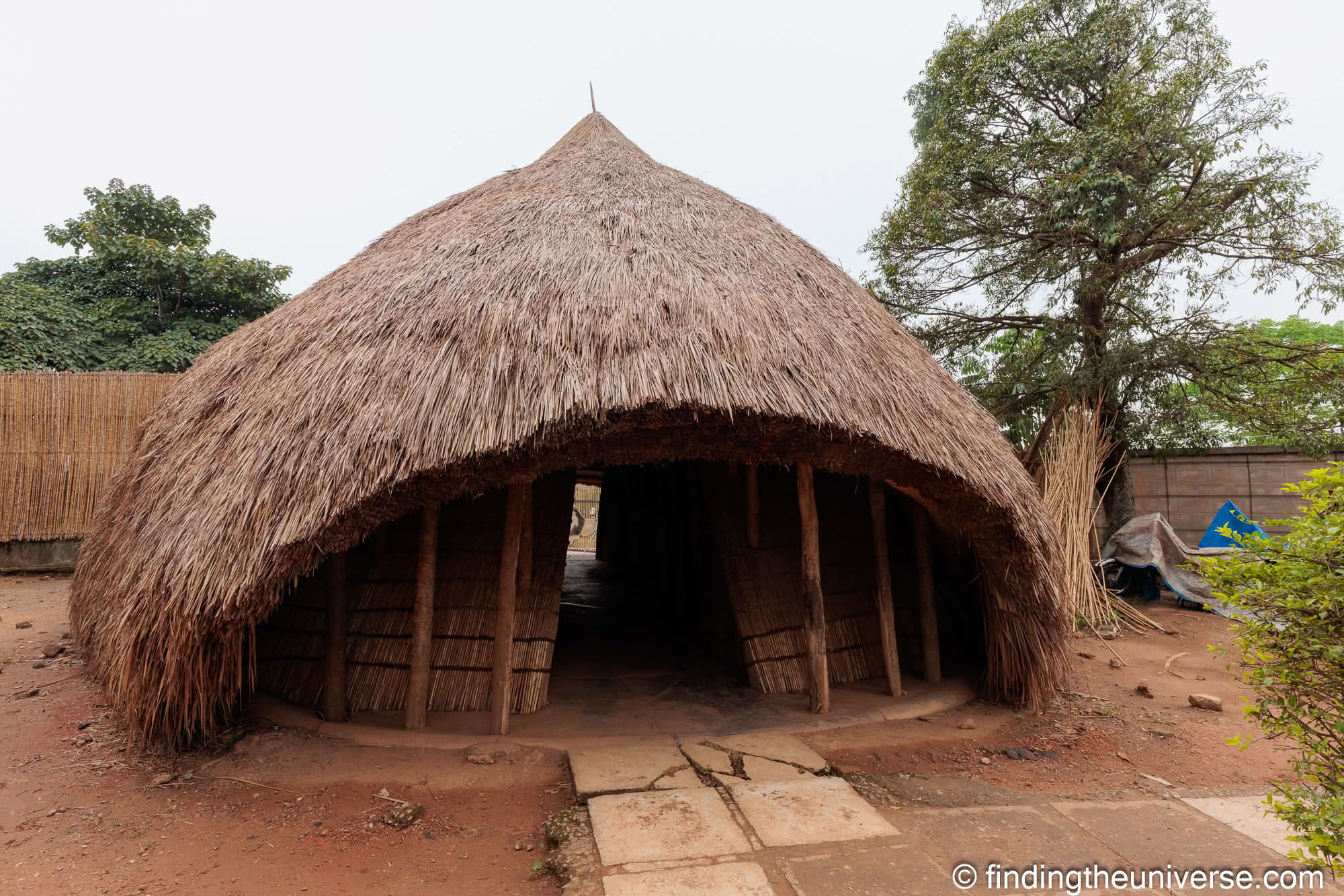

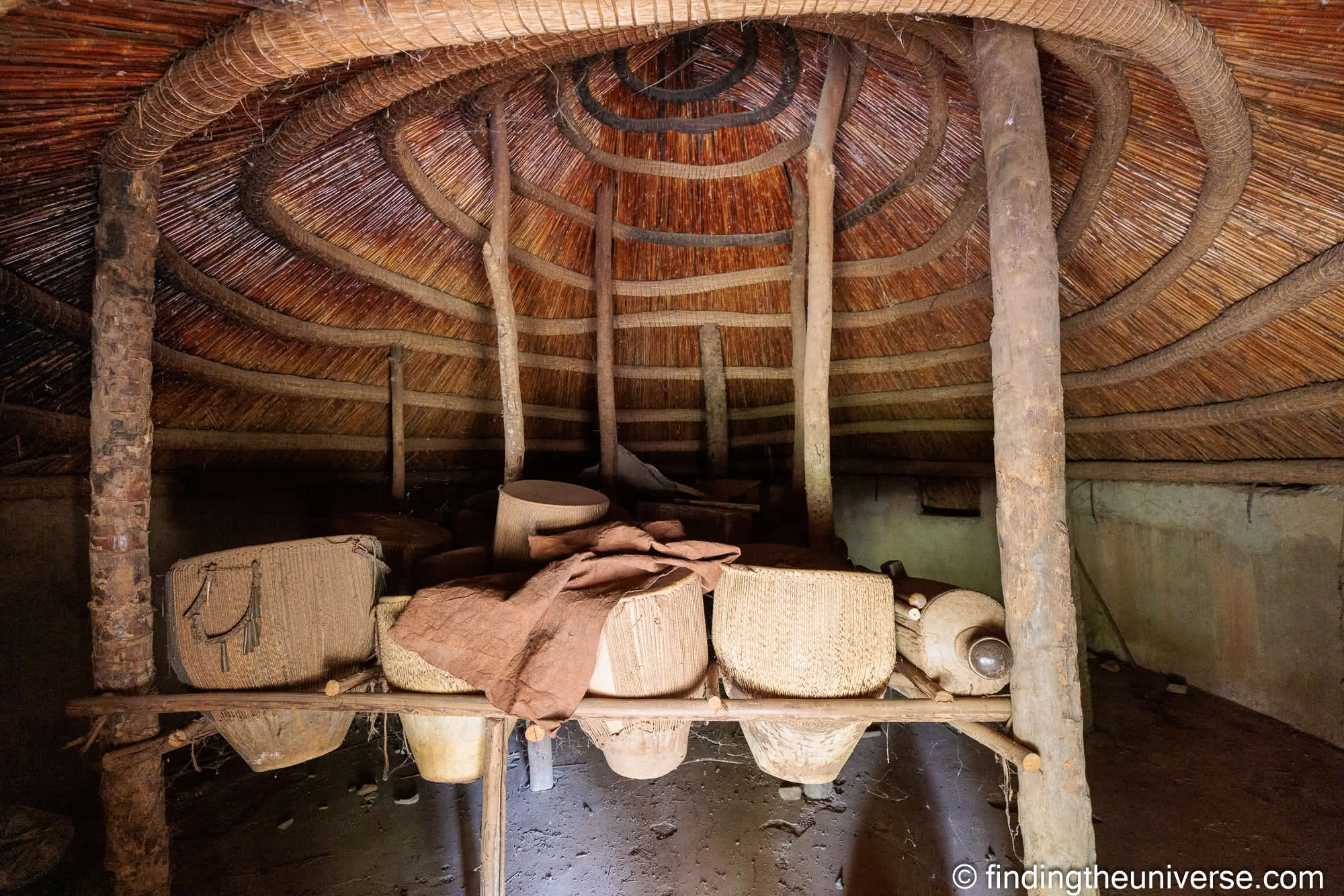

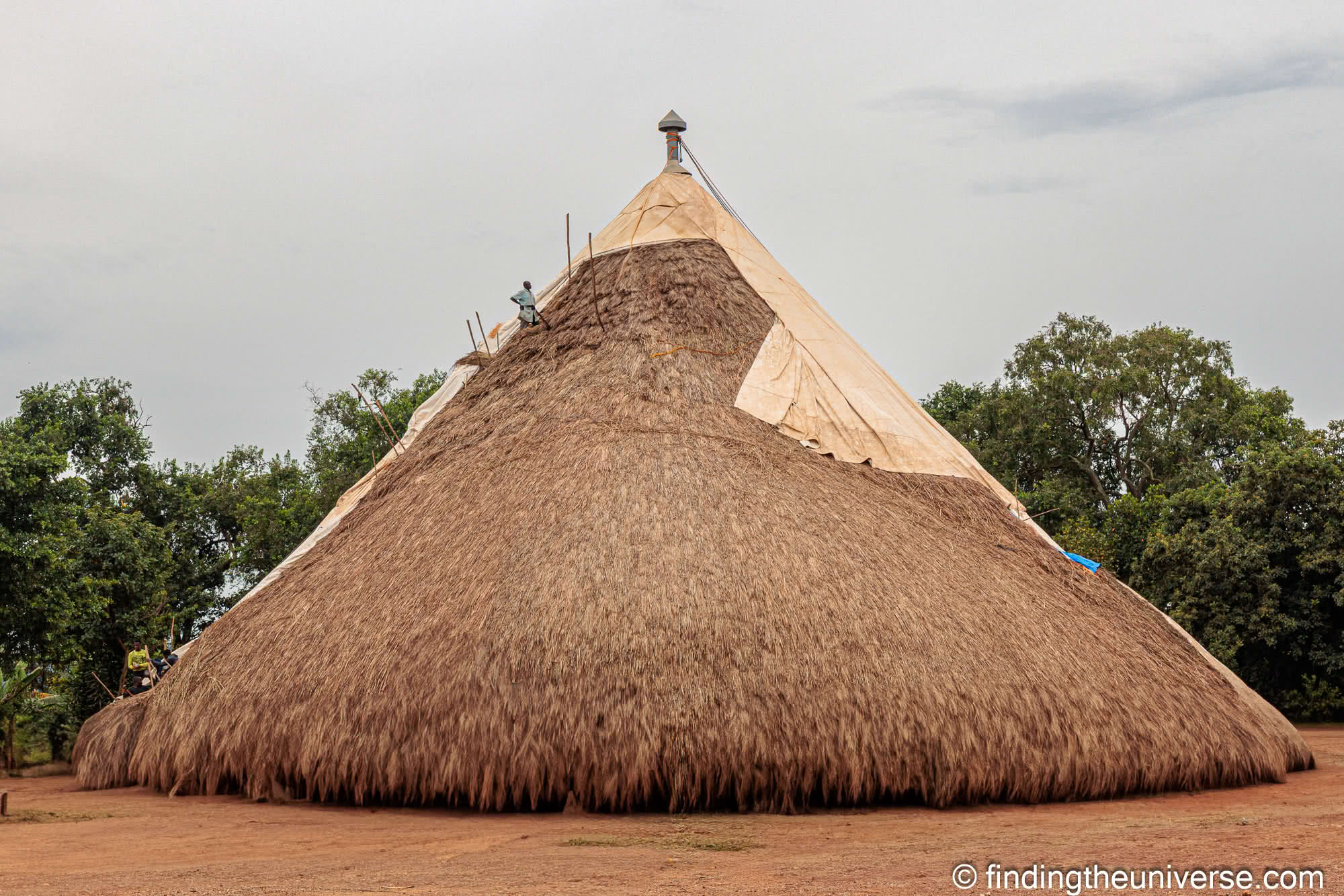

Wamala Tombs
If you are interested in tombs and Baganda culture, you may also want to add a visit to Wamala Tomb to your list. This is smaller and less central burial place of the 29th Kabaka of Buganda Ssekabaka Ssuuna ll who ruled from 1832 to 1856. By most accounts, he was not a very nice man who had almost all his brothers executed!
This is a smaller and less well known site compared to Kasubi. The tomb is inisde a traditional thatched building like that in Kasubi. There is also the remains of the former palace, tomb of Suuna’s mother, and a collection of royal artifacts.
Note that the Wamala Tombs are about a 30 minute drive north of central Kampala. If you are wanting to visit Wamala Tombs, you might consider this tour which also includes visits to Kasubi Tombs, Kabaka’s Palace, and the central markets.
Kabaka’s Palace (Mengo Palace)
The Kabaka’s Palace, or King’s Palace, is the traditional home of the Buganda King. The palace, which is also known as Lubiri and Mengo Palace, can be found on the top of Mengo Hill, and the location offers excellent views of the surrounding city.
Today the palace grounds are open to the public to visit, although you can’t go inside the actual palace residence (Twekobe Palace). The Twekobe Palace is no longer used as a residence but is still used for official visits and ceremonies The main place of business for the Kabaka is at the Bulange which is connected by a straight road known as the Kabaka Anjagala or “Royal Mile”.
So the visit takes place primarily outdoors. Visits are guided, you basically turn up at the entry gate. pay the entry fee, and a guide will be allocated to you.
When we visited we had an excellent English-speaking guide named Fred who showed us around the grounds and explained a lot of the history of Uganda. As well as being home to the impressive palace building, the grounds are also home to the torture chambers of Idi Amin.
These underground concrete cells were the final holding location of anyone deemed a threat to Amin’s regime, and it’s estimated that over 200,000 people were murdered here, their bodies dumped in a nearby lake.
This dark period of Ugandan history is included on the tour, and is in stark contrast to the pretty palace on the hill. Desperate messages written in charcoal and blood and damp stained concrete are all that remains of these thousands of lost lives.
As well as the above, the tour includes other interesting information on Ugandan history. Our guide was also knowledgeable about the trees, fruits, and plants we saw along the walk.
We learnt about bark cloth, a traditional fabric made from tree bark which long predates woven textiles. Many Ugandan artists use it as a traditional medium upon which to paint. There is a small shop which sells painted barkcloth and other traditionally made items which make for nice Ugandan souvenirs.
Overall, a visit to the Kabaka’s Palace grounds is a good way to learn about Ugandan history, including it’s darker times. The on-site guides we visited with were really excellent, and this was a very worthy experience.
There is of course a fee to visit. You can visit yourself, as we did, or as part of a larger day tour. The majority of tours of Kampala will include Kabaka’s Palace, such as this one or this one.
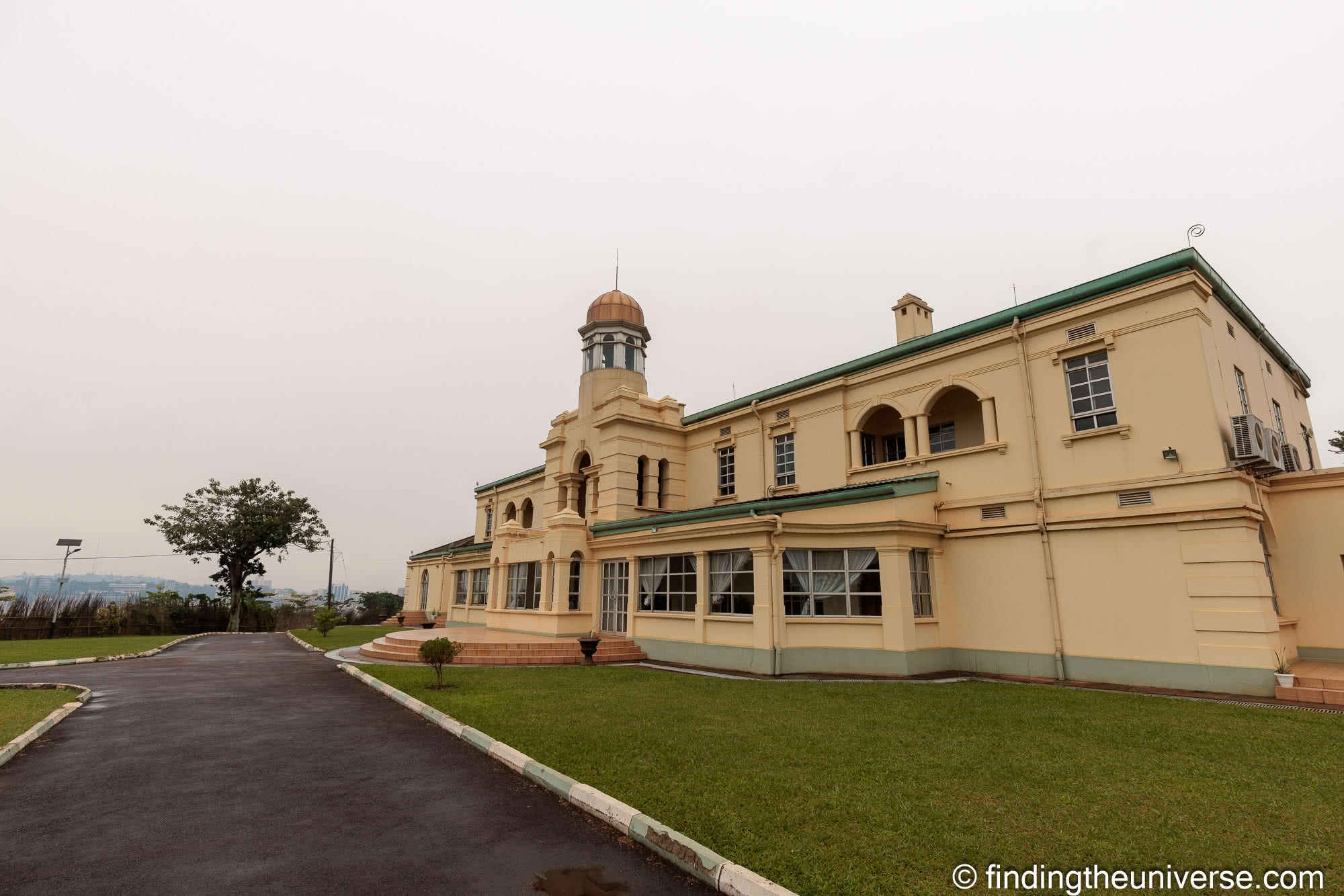

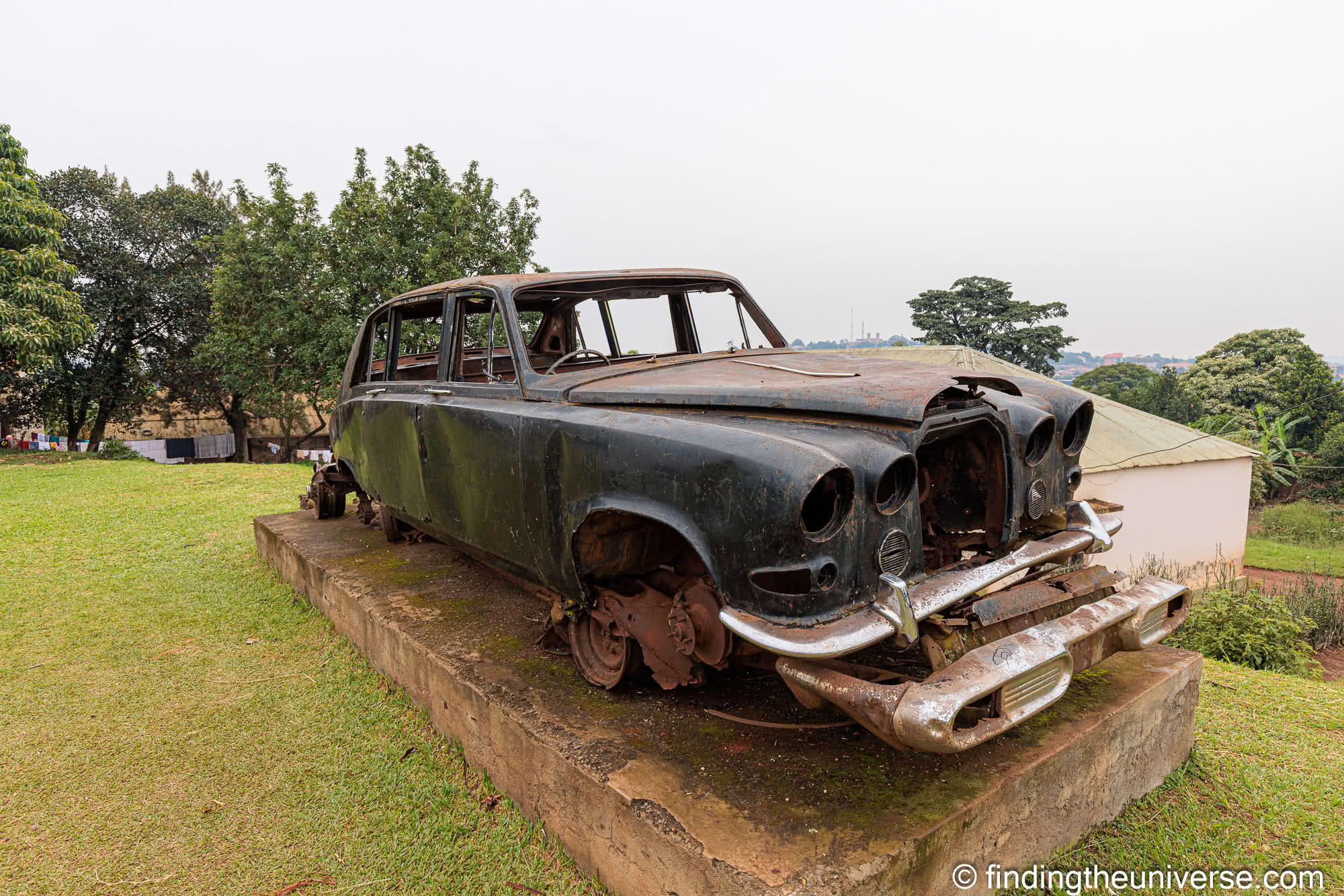

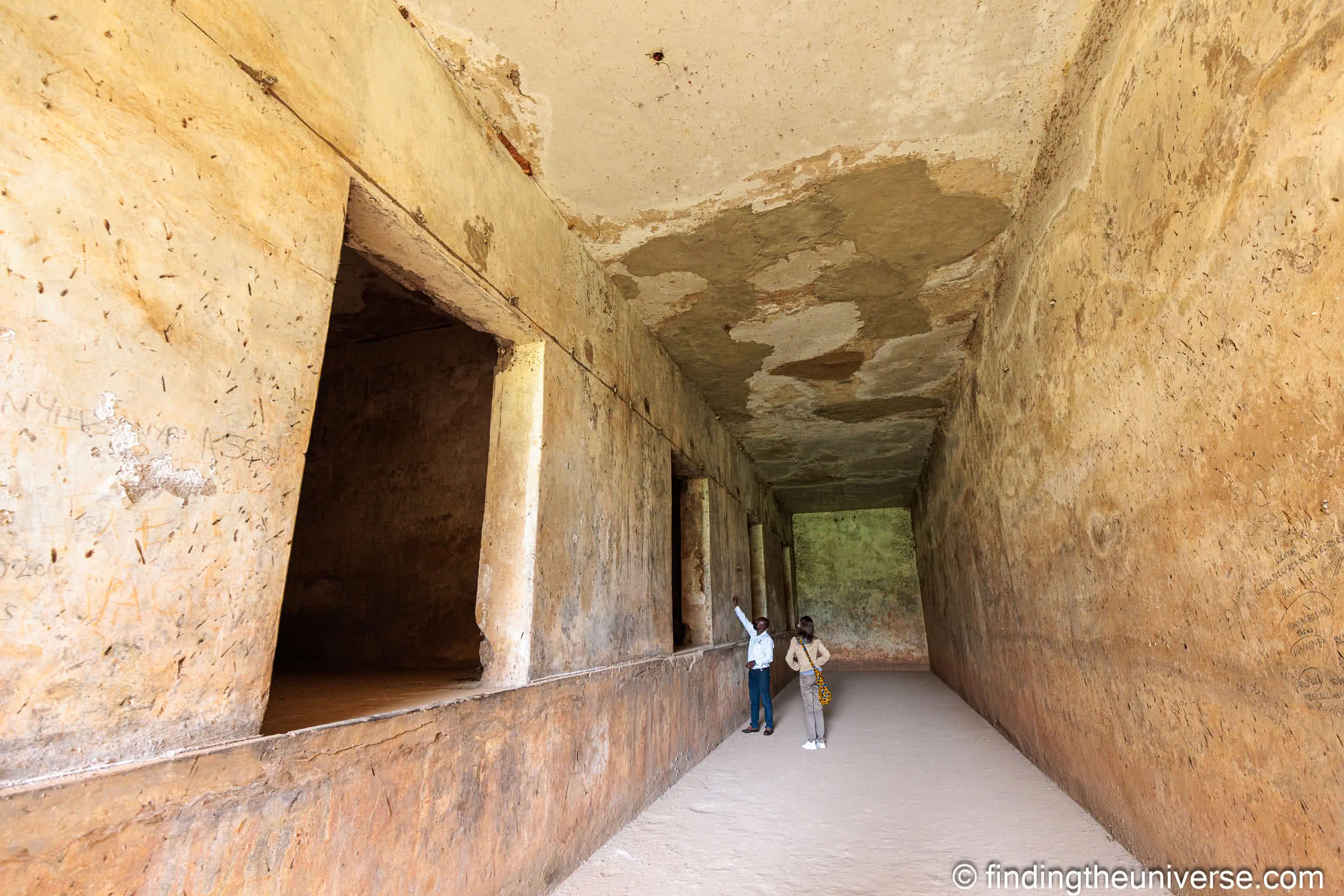

Uganda Museum
Founded in 1908, the Uganda Museum is one of the best places in Kampala to visit to learn about the history of the country. It’s also the oldest museum in East Africa.
It features a variety of exhibits, covering the history and culture of the Ugandan people, with objects including musical instruments, weapons of war, barkcloth paintings, traditional medical supplies, clothes, and lots more. There’s are also exhibits from pre-historical times, featuring fossils and other relics that point to the history of human evolution in the region.
Outside, you’ll find the cultural village, which features a range of different traditional buildings and items that were used during different periods in history. This was our favourite part of the museum, and it was so interesting to see the different styles of house as well as the items used by the different tribes across Uganda.
The museum is not huge, and can definitely be visited in 2 to 3 hours. There is an admission fee. You can visit on your own or you can get a guide if you prefer a guided visit. You can see more about opening times and what you can see at the official museum website.
Note: the Uganda Museum closed for renovations in August 2024 and is due to reopen in mid-2025. Check the official website for the latest status.
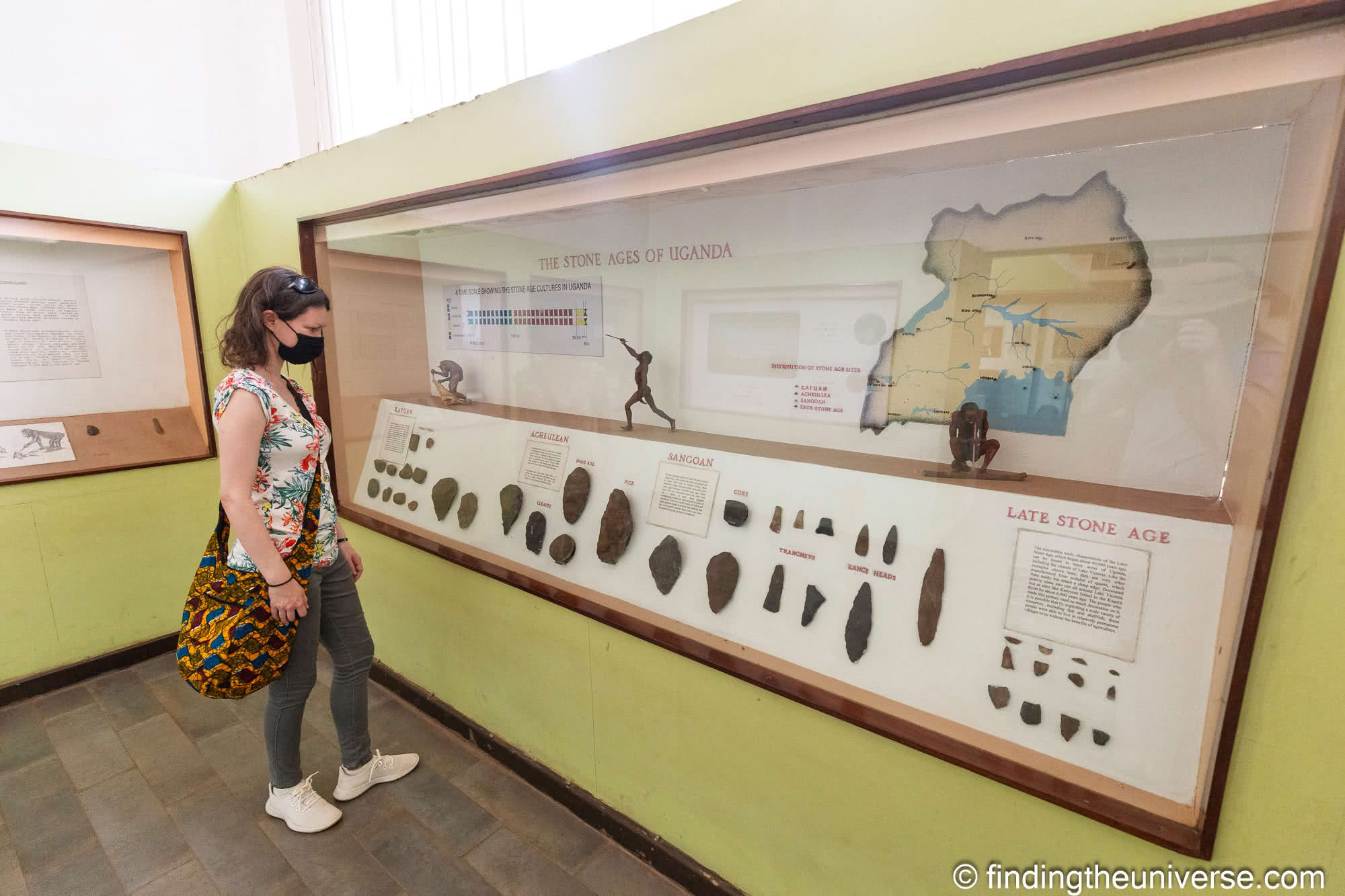

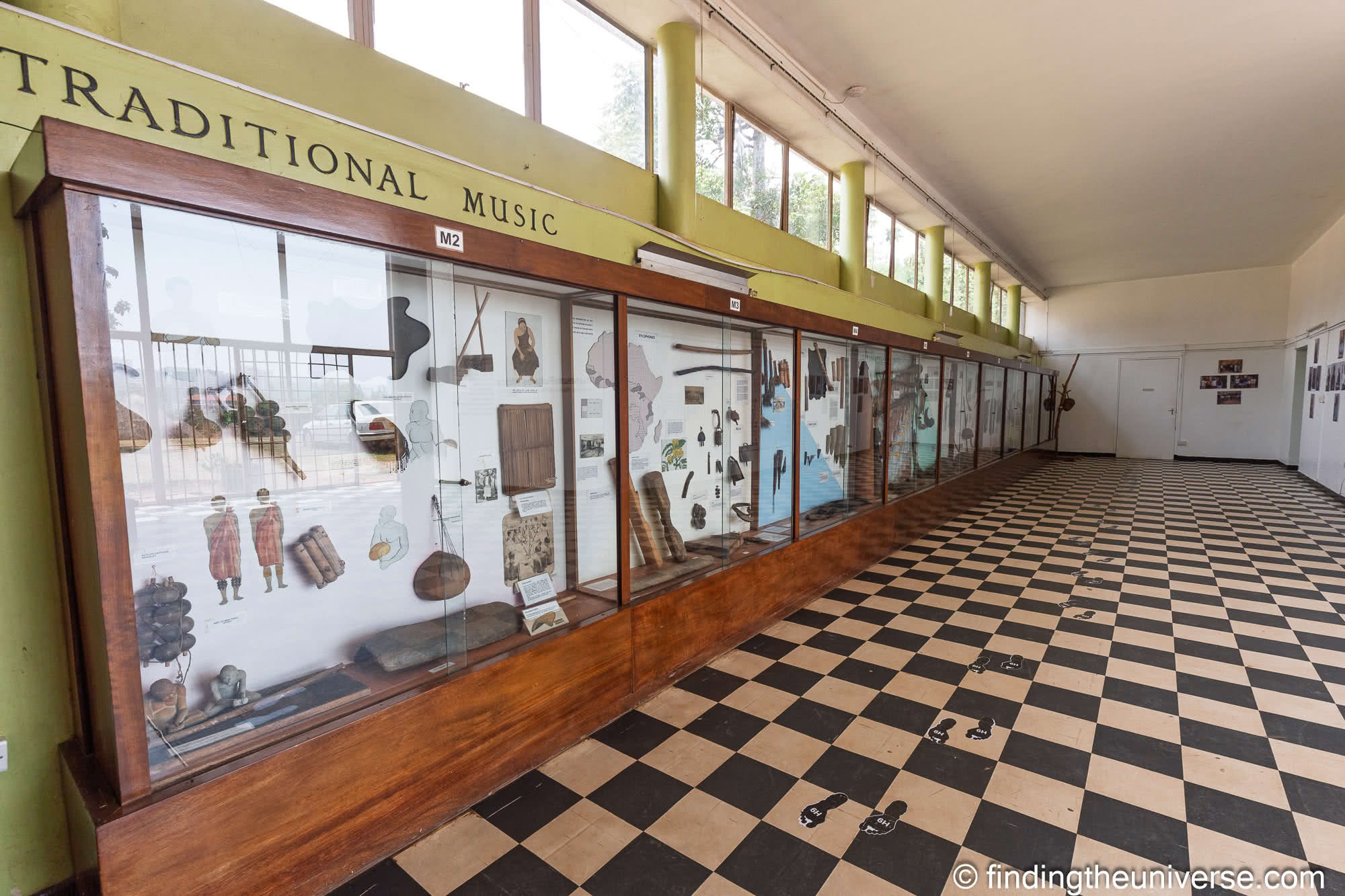

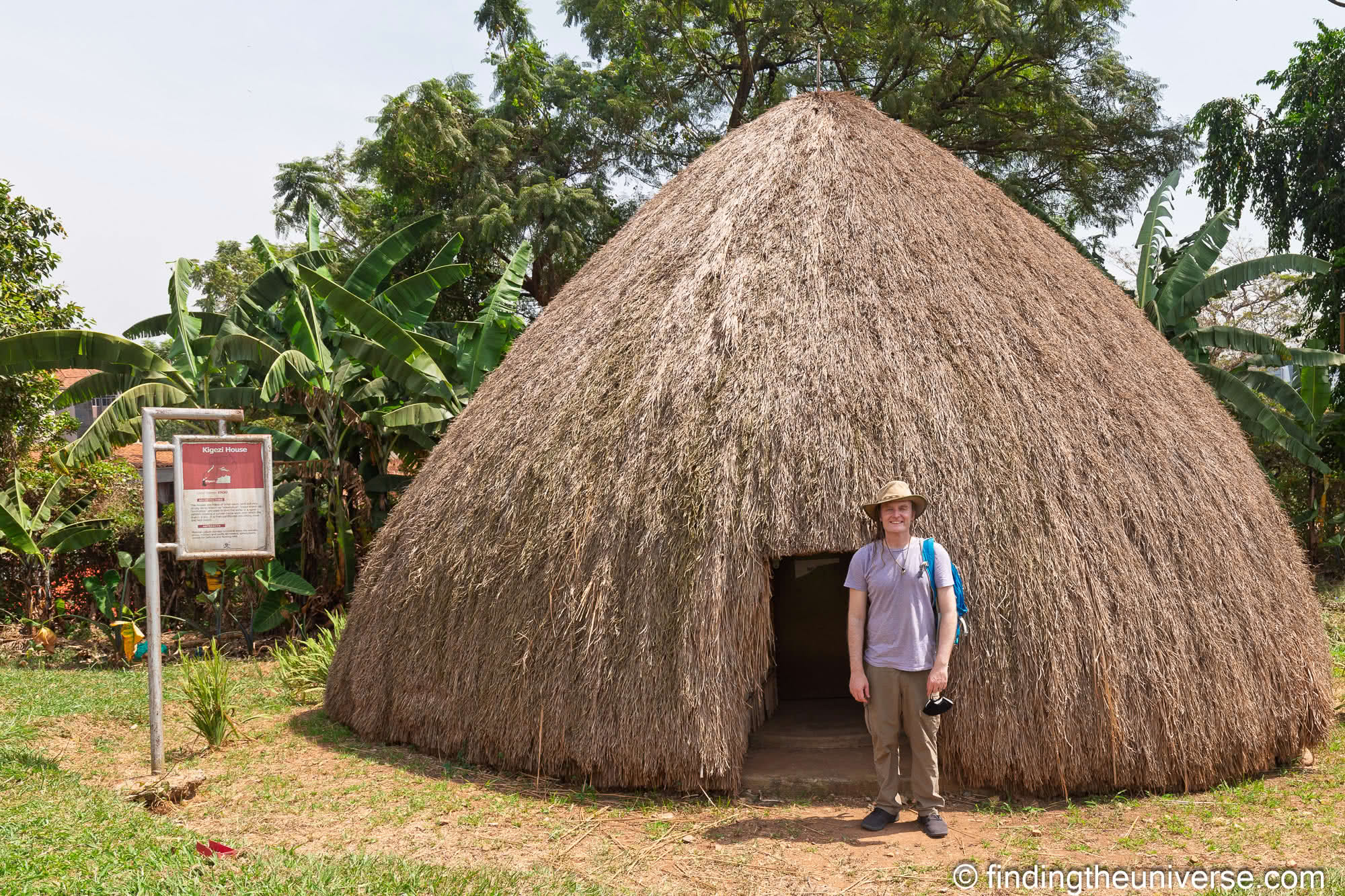

Independence Monument
Uganda gained independence from the British on October 9, 1962, and this monument, which was unveiled the day before the date of independence, symbolises that moment.
The 29 foot high concrete sculpture, which can be found in the King George V Jubilee gardens, depicts a mother lifting her child into the air with ropes around her legs. The ropes symbolise the freedom from colonialism, while the child’s excitement showcases the joy of freedom.
The statue is also depicted on Ugandan currency, appearing on paper notes between 1,000 and 50,000 UGX. So it might be familiar to you before you even see it!
It’s free to visit the Independence Monument in Kampala. It is also often included on tours such as this one and this city-centre walking tour. We visited it as part of this guided walking tour.
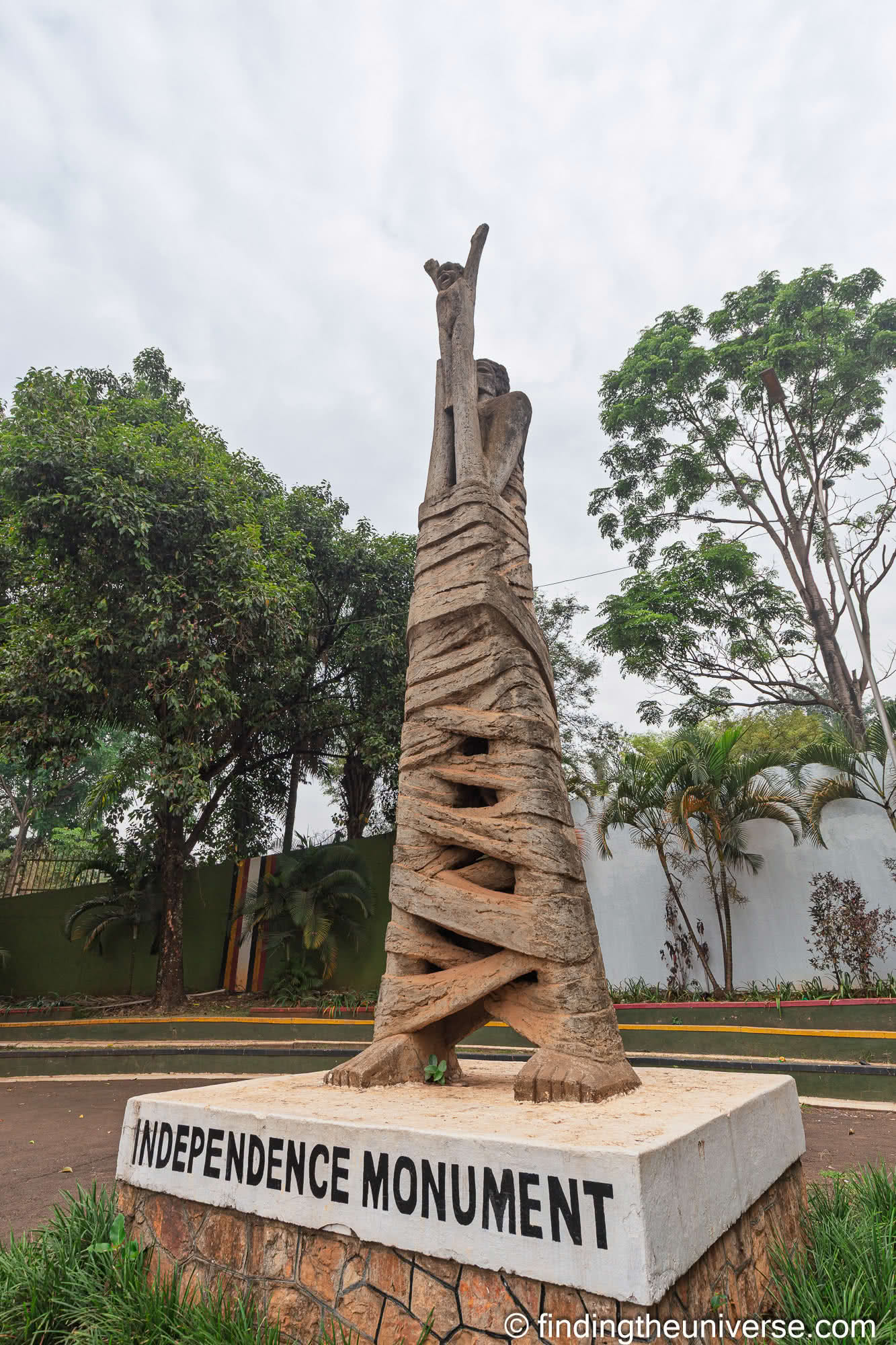

Other Historical Monument and Statues in Kampala
In addition to the Independence Monument, there are also a number of other monuments and statues that you can see around Kampala. These include:
- World War Memorial Monument – built by the British in 1945 to remember the Ugandans lost in the first and second world wars. One of the oldest memorials in Kampala. Found on Kampala Road by the central police headquarters.
- King Mutesa II Monument – Monument to the 35th King and first President of Uganda who died in exile in 1969. The monument shows him in British military fatigues, which is a nod to his service as a Queen’s Grenadier Guard. He was also the first Black Commissioned Officer in the Grenadier Guards. This was originally located at the intersection of Speke Road and Nile Avenue, but due to road works it has been moved to sit between the Serena Hotel and Imperial Royale Hotel
- The Cenetary Monument – Commemorating the centenary of the Kampala City Council, this monument symbolizes the identity of the city’s governing authority. Found in Centenary Park along Jinja Road
- Stride Monument – Created to honor the 2007 Commonwealth Heads of Government Meeting, this monument features a family moving forward together, symbolizing the unity of the Commonwealth. Found between the Parliamentary Gardens and the Kampala Serena Hotel
- Long Split Drum Statue – The statue is of a tall drum or engalabi, a traditional long, cylindrical drum covered with skin. It is located at the Nantawete roundabout along the Kabaka Anjagala, or road between the Kabaka’s Palace and the Bulange.
- Wildlife Statues – You’ll find a number of wildlife statues along the roads in central Kampala, particularly Old Kira Road. Statues include a lion, gorillas, cranes, giraffes, impala and many other native wildlife species
Note that there is often security around public memorials and monuments and around government buildings in Uganda. So you may be asked why you are there and asked not to take photos. For example, we were stopped at the war memorial by police and we were only allowed to approach and take a photo because we were with a local guide.
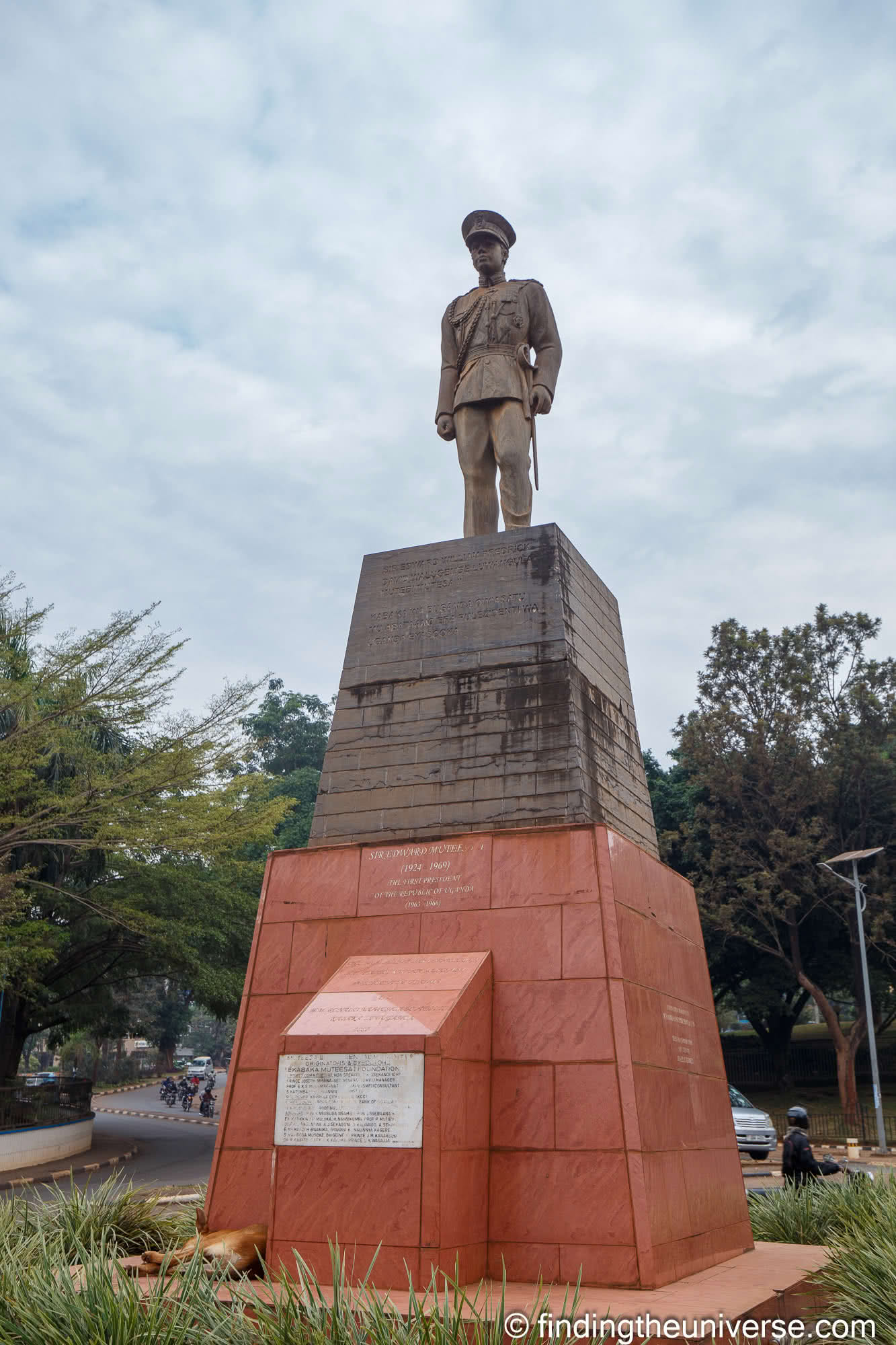

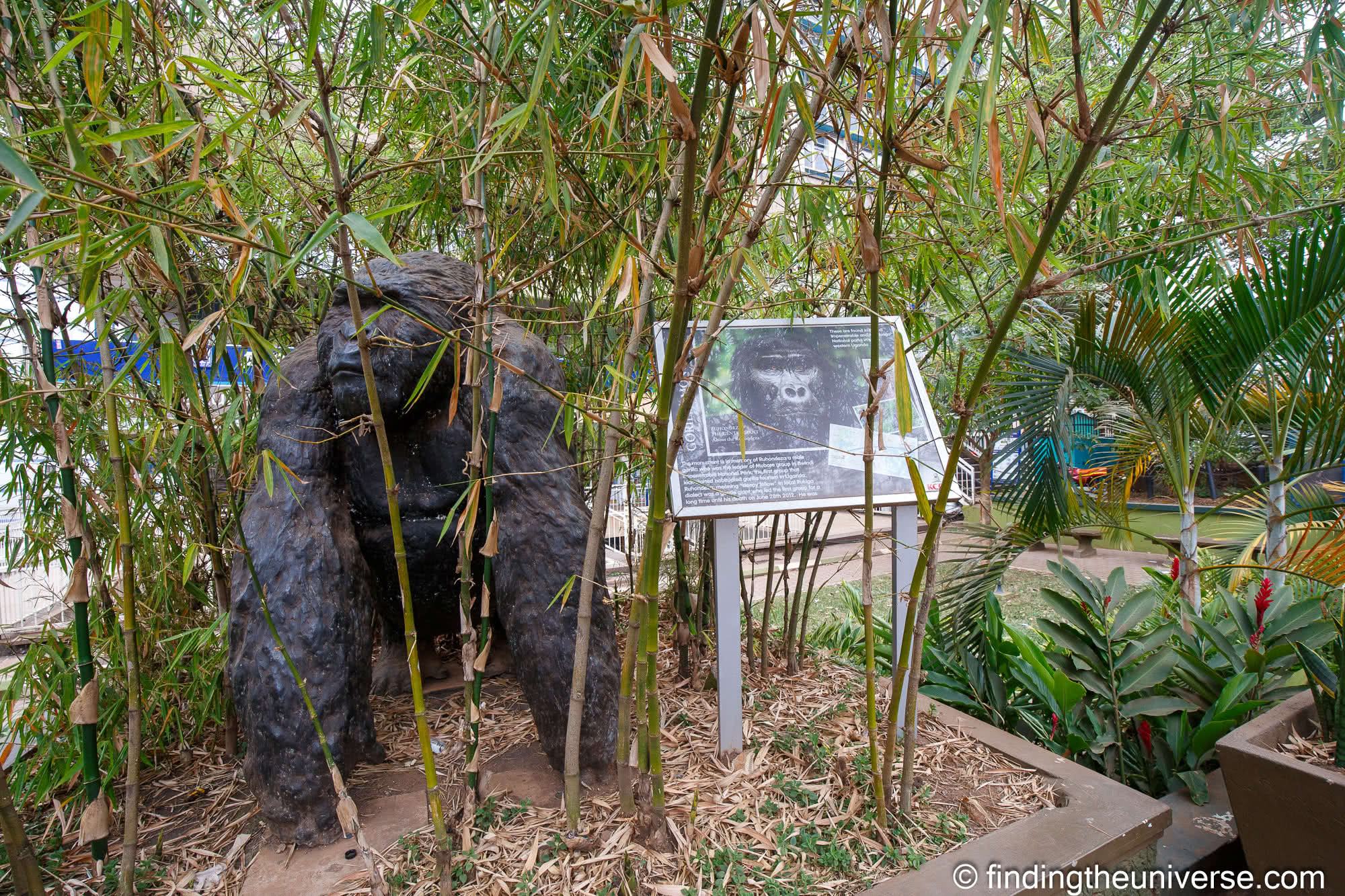

Saint Paul’s Cathedral Namirembe
The next few entries in our list of things to do in Kampala are places of worship for some of the major religions you’ll find in Uganda. We’ve visited all of these, and each location is interesting and worth visiting in its own right. It just depends on your interests.
The first in the list is Saint Paul’s Cathedral Namirembe, more commonly referred to as Namirembe Cathedral. This is the oldest Anglican cathedral in Uganda and the headquarters of the Anglican Church of Uganda.
The church was consecrated in 1919, and is the fifth church building to be found in this location, with the first four structures (dating from 1890) all having been abandoned or destroyed for various reasons.
The present-day church is an impressive large red building with a domed roof, constructed from earthen bricks and earthen roof tiles.
The church can be found on the top of Namirembe hill, just to the west of the city’s central business district. As with most of the hills in the area, the hilltop location offers excellent views of the surrounding city.
Note that it is free to visit the outside of the cathedral but if you wish to go inside as a visitor there is a fee which includes a guided tour. The church is of course a working church so visits are not always allowed if worship services or other events are taking place.
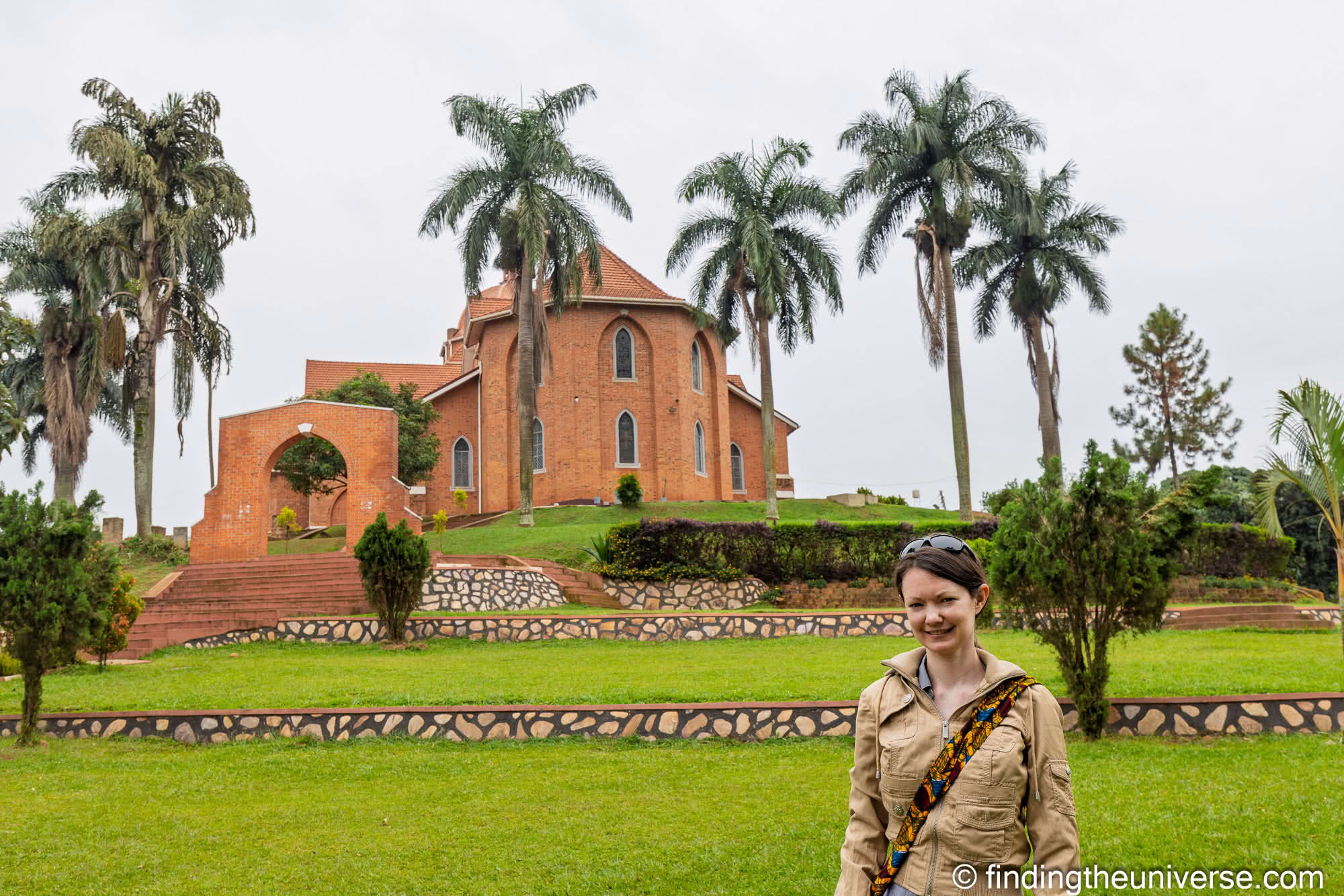

St. Mary’s Cathedral Rubaga
St. Mary’s Cathedral Rubaga, also commonly called Rubaga Cathedral, is found at the top of Lubaga Hill, which is just east of the city center. This commanding hilltop location offers excellent views of the surrounding city.
This is the Roman Catholic cathedral of the Archdioceses of Kampala, which is the oldest diocese in the country. Rubaga has been the seat of the Bishop since 1883, and the cathedral itself was consecrated in 1925. It was initially set up by the White Fathers, French Roman Catholic missionaries, who were given the land by the 31st Kabaka of Buganda.
The cathedral is a large brick building with two impressive towers on the front, and the capacity to hold up to 5,000 worshippers. There are some interesting stained-glass windows, murals, and other art pieces that tell the story of the Catholic Church in Uganda. We had a guide from the church who gave us a short tour inside.
Today, most Ugandans identify as Christians (over 80%) and Roman Catholicism is the largest denomination, followed by Anglicism.
The church is free to visit although donations are encouraged. The church is of course a working church so visits are not always allowed if worship services or other events are taking place.
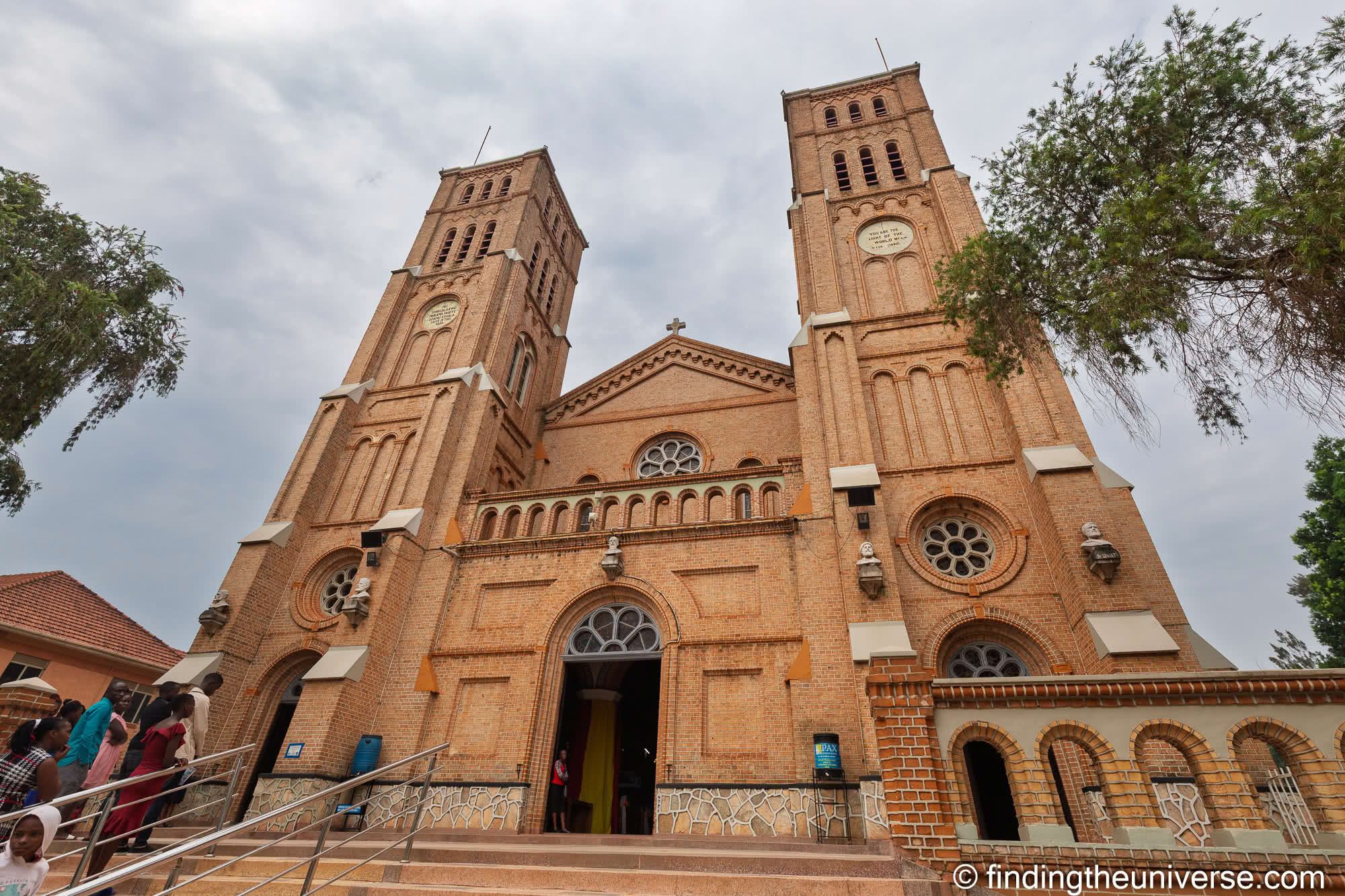

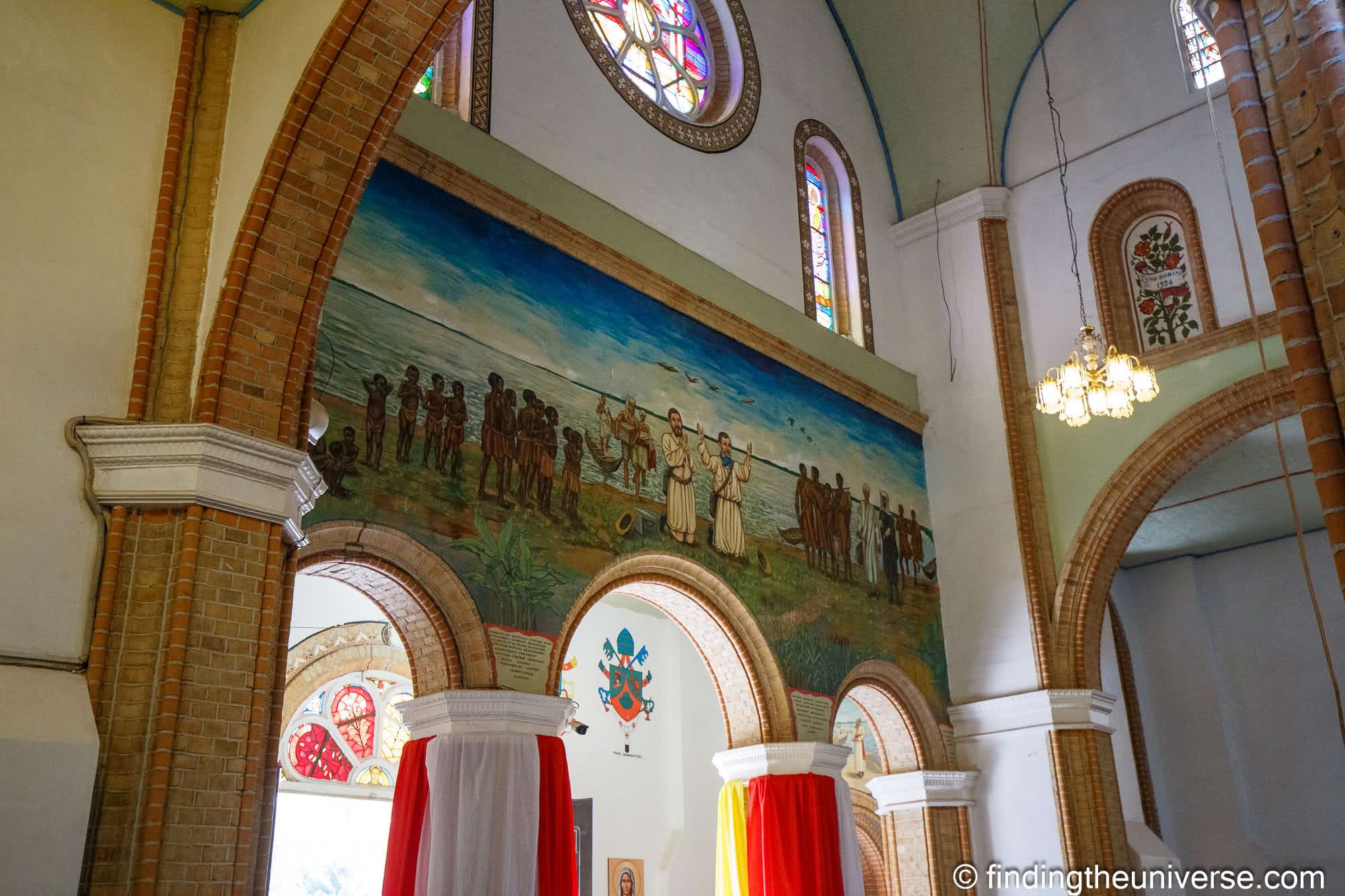

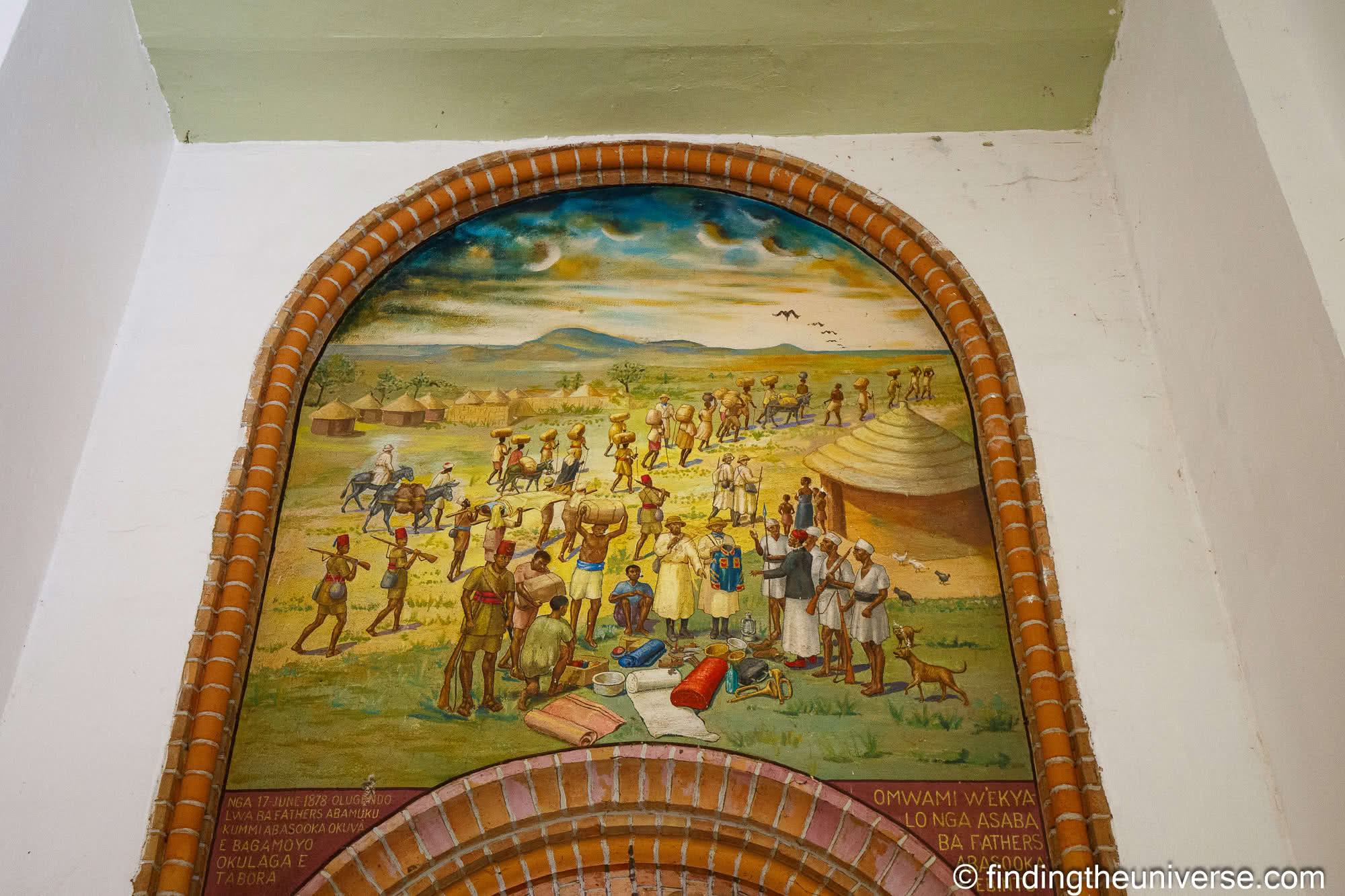

Baha’i House of Worship
The Baha’i faith is one of the smaller and newer faiths in Uganda, but it’s main house of worship and location is still nonetheless worth a visit. Found on Kikaya Hill on the edges of the city, this imposing octagonal building towers 127 feet above the ground, topped by a large green dome. It can be seen for miles around.
The building, which dates from 1958, is found on a fifty-acre estate which includes lovely, landscaped gardens as well as a number of other buildings. It has a stunning location.
Honestly, we knew very little about the Baha’i faith before we visited, so the opportunity to learn about that was welcomed. All visits are by free guided tour, and our guide was excellent, showing us the key highlights of the property and answering all our questions about the history of the building and the Baha’i faith. It is definitely something a little bit different and worth the small effort to get here in our opinion.
We actually visited twice, the first time we took a ride-share here but arrived too late as it had already closed. You can only visit the grounds during visiting hours. On our second visit we planned a bit better and arrived during opening hours.
We signed in and were given a tour by a lovely guide named Esther. She told us a lot about the history of the faith and of the Kampala temple. No services were happening when we visited so we were allowed to go inside, no talking or photography is allowed inside.
As it’s found to the north of the city center it is a good location to stop if you are heading north out of the city, perhaps to Ziwa Rhino Sanctuary or further north to Murchison National Park.
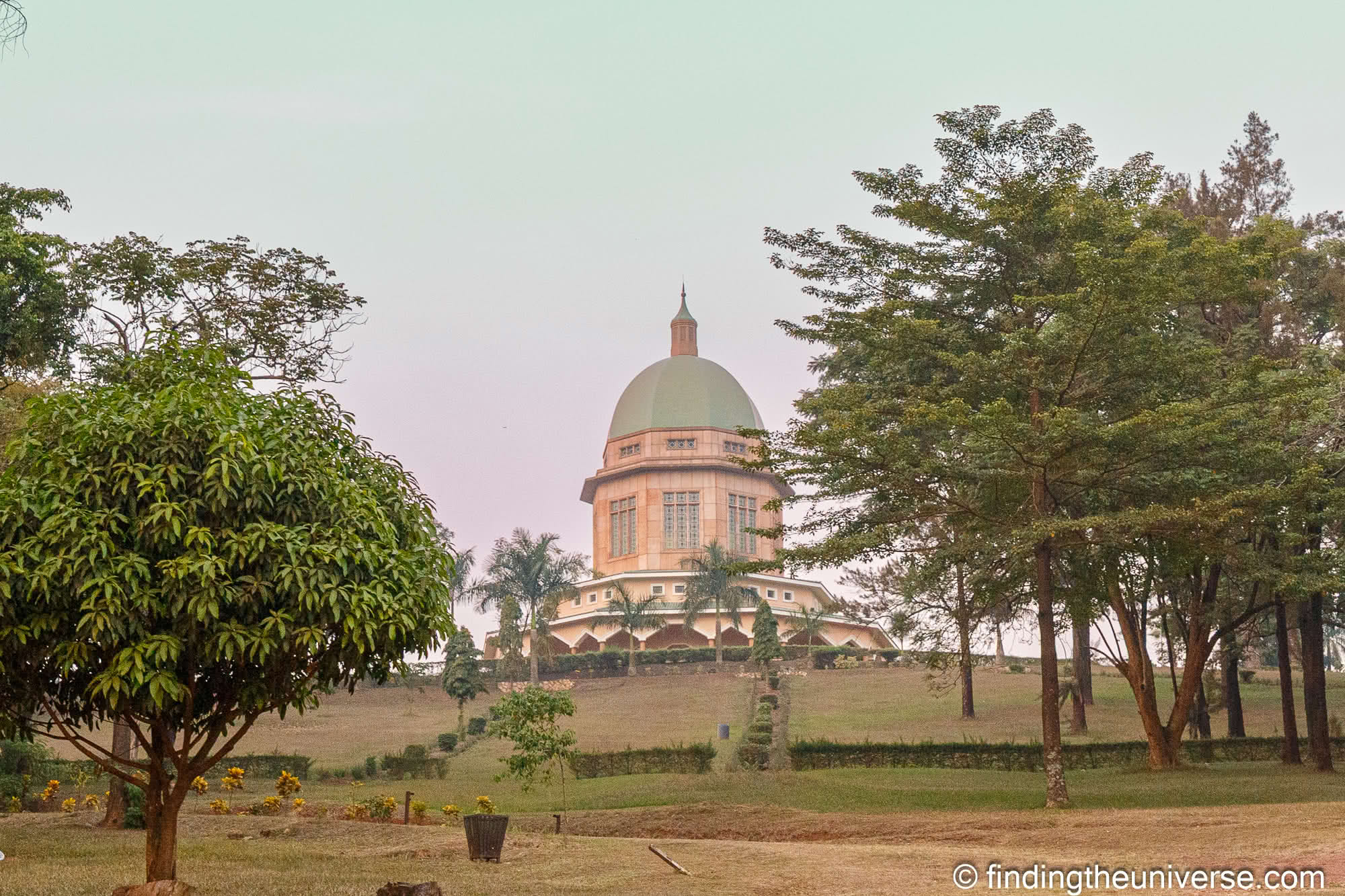

Uganda National Mosque
The Uganda National Mosque, previously known as the Gaddafi National Mosque, is the largest mosque in East Africa. Around 15% of the population of Uganda is Muslim, and this mosque has room for almost 20,000 worshippers!
Construction of the mosque actually started in 1972 during the regime of Idi Amin, however the instability of the regime meant that construction halted in 1976. It wasn’t until 2001 that construction restarted, thanks to the support of the Libyan leader Colonel Muammar Gaddafi. The mosque finally opened for worship in 2007 and was renamed to the Uganda National Mosque in 2013 after the death of Gaddafi.
The mosque has one minaret, and it is open to visitors to climb to the top. From the top you can get great views over the city. This minaret was actually featured in a Season 31 episode of The Amazing Race (2019), where they had to climb and count all the steps (272 of them!). If you plan on climbing, just note that you need to be able to climb up and down all those steps to get to the top as there’s no elevator. We were the only ones inside the tower during our visit.
The mosque can be visited by non-Muslims as part of a tour. Just note that during Fridays and other holy days, you may not be allowed to go inside the main parts of the mosque. But you should still be able to visit the exterior and climb the minaret.
There is an entrance fee to visit as a foreigner. We visited as part of this guided walking tour and were assigned to a mosque guide for this part of the visit. The interior of the mosque is really architecturally impressive, but for us the highlight was going up the tower for the views across the city.
As with any religious building you will want to observe the dress code. All visitors should dress modestly. Women should wear loose fitting clothes covering to the wrist, ankle (preferably a long skirt), and cover their heads. Men should wear trousers and shirts with sleeves. Coverings are available at reception to borrow (as part of entrance fee).
When we visited Jess felt a bit suffocated as it was hot and she had to wrap a large shawl (kanga) around her waist (she had on pants/trousers not a skirt), wear a head scarf, and a face mask (COVID-19 regulations at the time). We also had to take our shoes on and off a few times and she spent a lot of time fumbling with the coverings and shoes. Overall she enjoyed it but it is something to keep in mind.
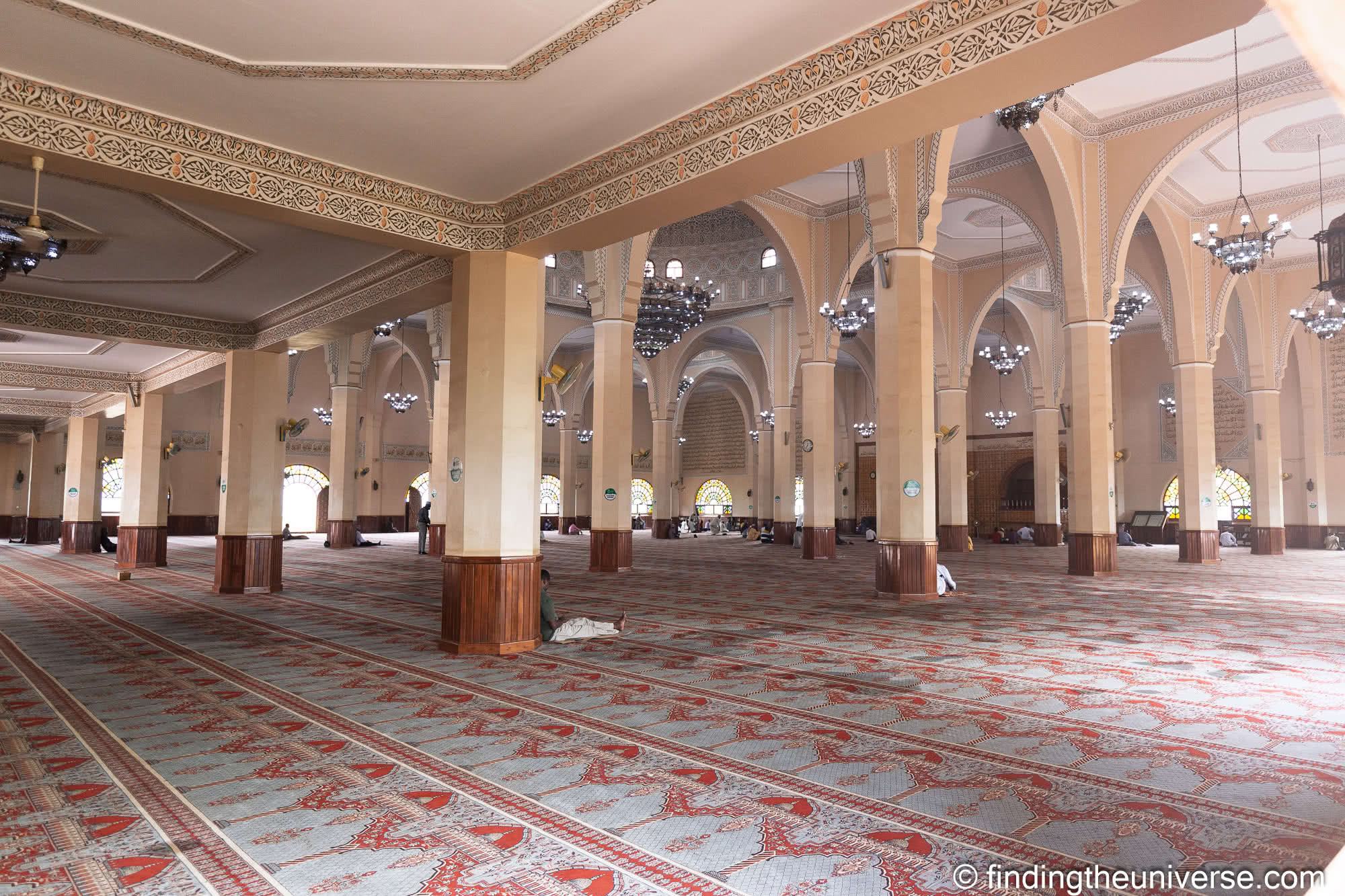

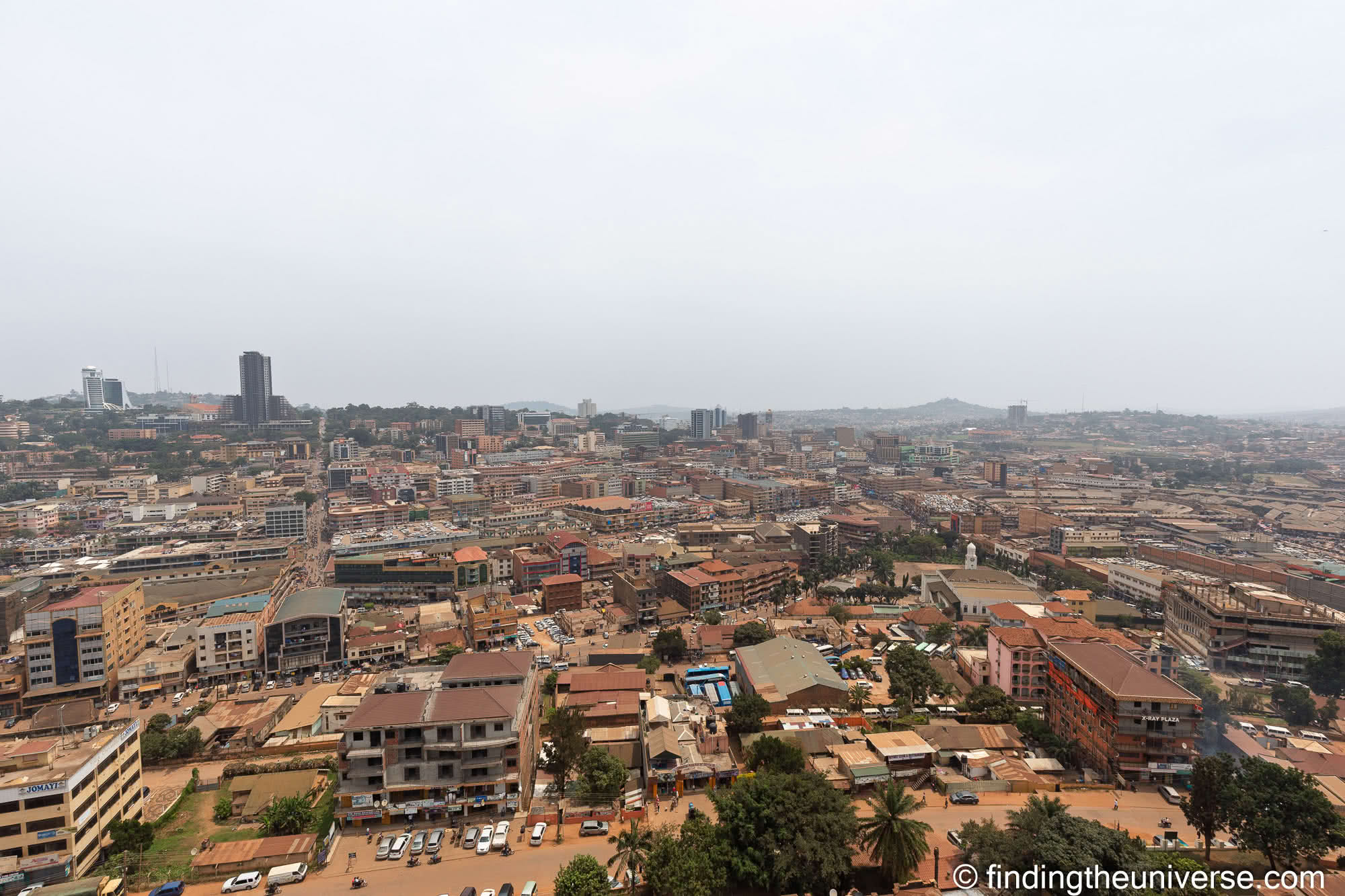

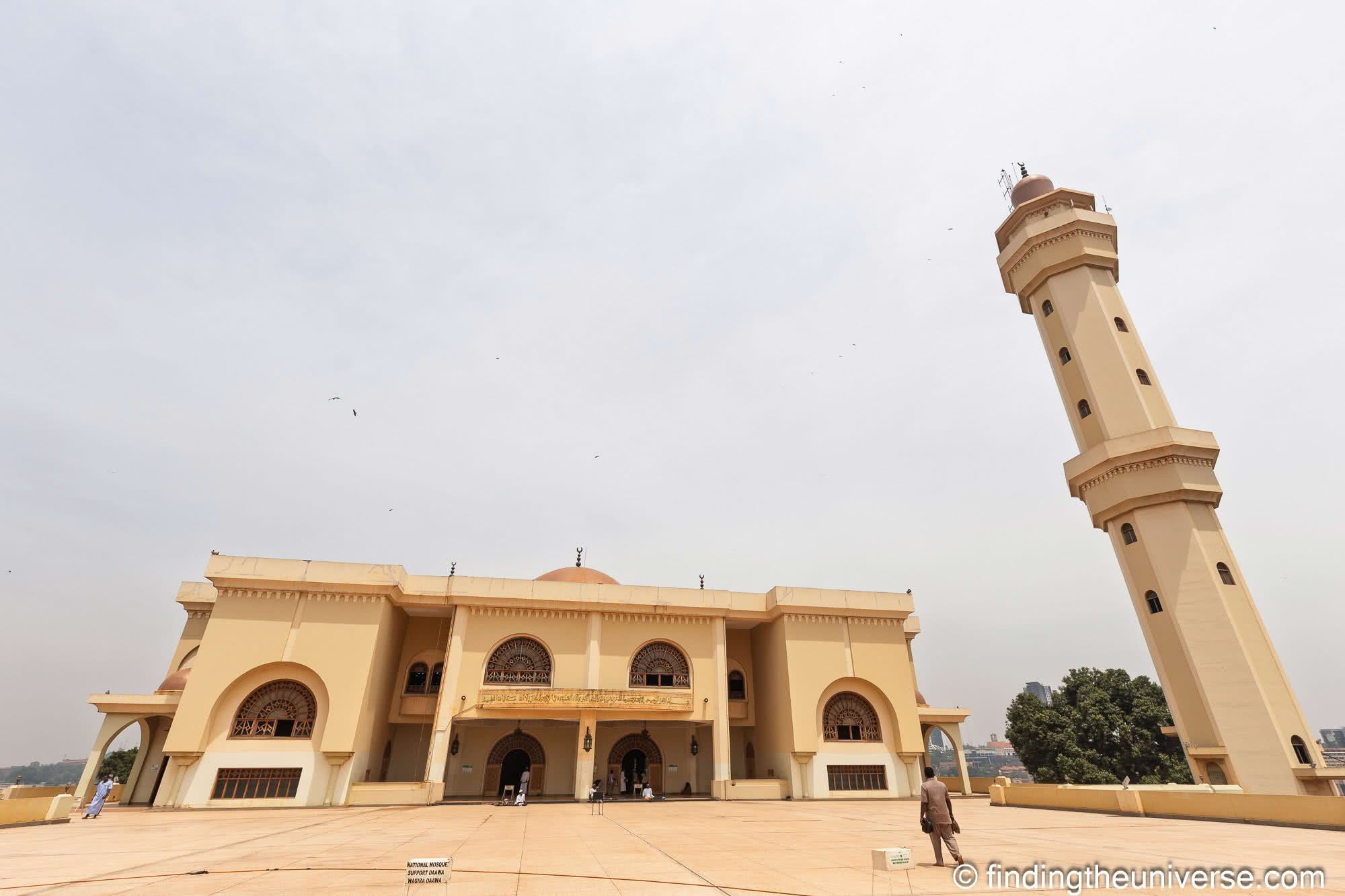

Uganda Martyrs Catholic Shrine Basilica
The Basilica of the Uganda Martyrs is a minor Catholic Basilica found in the township of Namugongo, around 7 miles northeast of Kampala.
The basilica is a unique design, consisting of a huge circular building, which was designed to replicate a traditional African hut. It’s also one of the most visited pilgrimage sites in Africa, as it serves as a shrine to the Uganda Martyrs.
The Uganda Martyrs were a group of 22 Catholic and 23 Anglican Christians, who were killed between 1885 and 1887. Many of the martyrs were members of the King’s Royal Court who had adopted Christianity against the King’s wishes, and whom he ordered to be executed. The majority of the martyrs (twenty-two men) were burned alive at Namugongo in 1886.
The death of the Uganda martyrs had a major impact on the political and religious landscape in Uganda. It resulted in widespread popular support amongst the British public for acquiring Uganda as a protectorate, which happened just a few years after the deaths of the martyrs. It also led to a more widespread adoption of Christianity in Uganda, with about 80% of the population today being a part of the Christian faith.
The 22 Catholic Ugandan martyrs were beatified in 1920, and canonized as saints in 1964. Since its completion in 1968 the Basilica has served as the focal point for the annual Martyrs Day Celebration. This is held on the 3rd June, which is the Feast of the Uganda Martyrs. On this day hundreds of thousands of people visit the shrine.
Pope Francis visited Uganda and the basilica in 2015. He celebrated Mass outside the basilica at Namugongo November 28, 2015.
However, you can visit the shrine at any time of year and explore the grounds and basilica during visiting hours. There was a small fee to visit for international visitors.
There is the bascilica, a little museum area, shrines to the martyrs, a small lake, an amphitheater, a small cafe, and a gift shop. It’s a calm and peaceful place and well worth a visit.
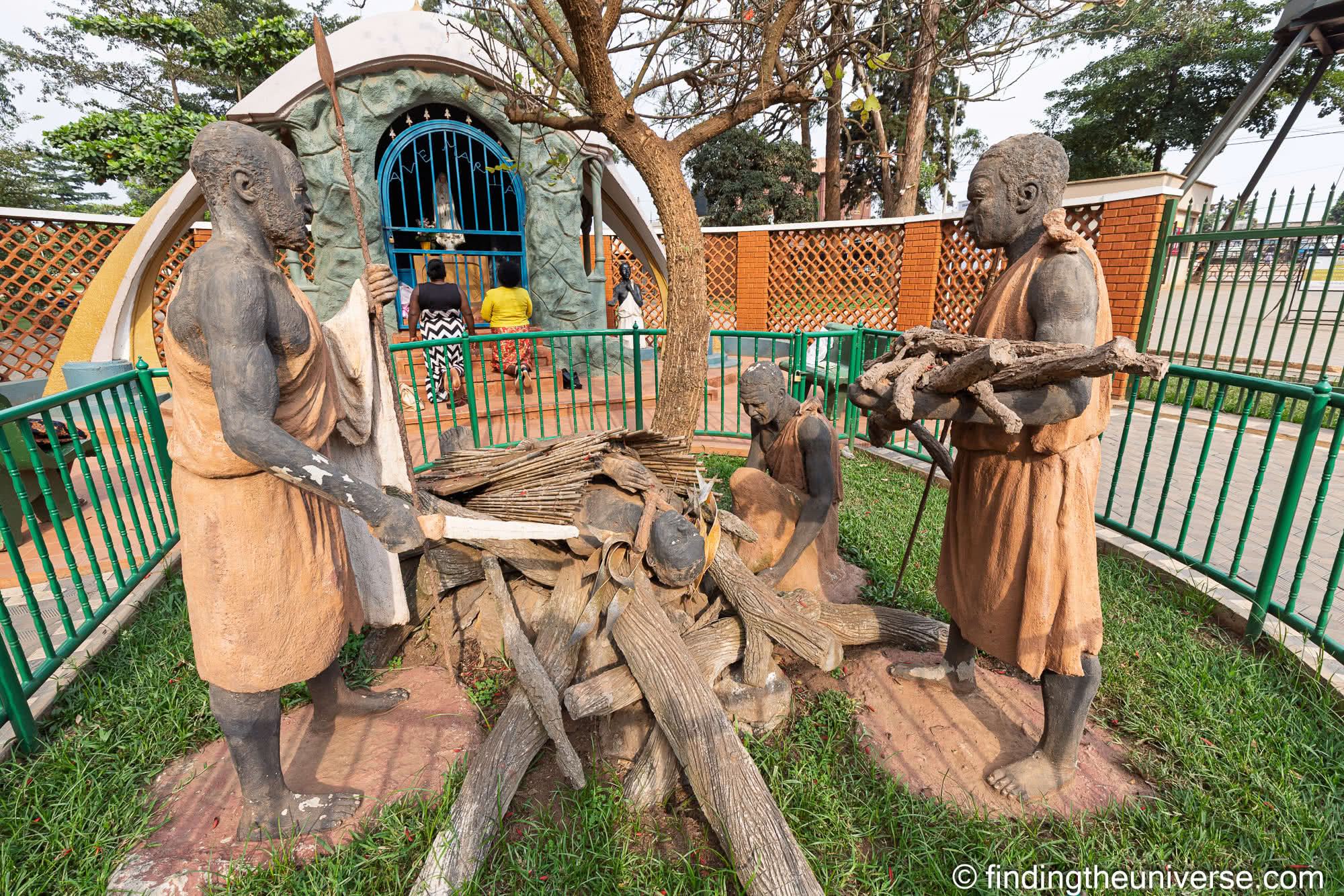

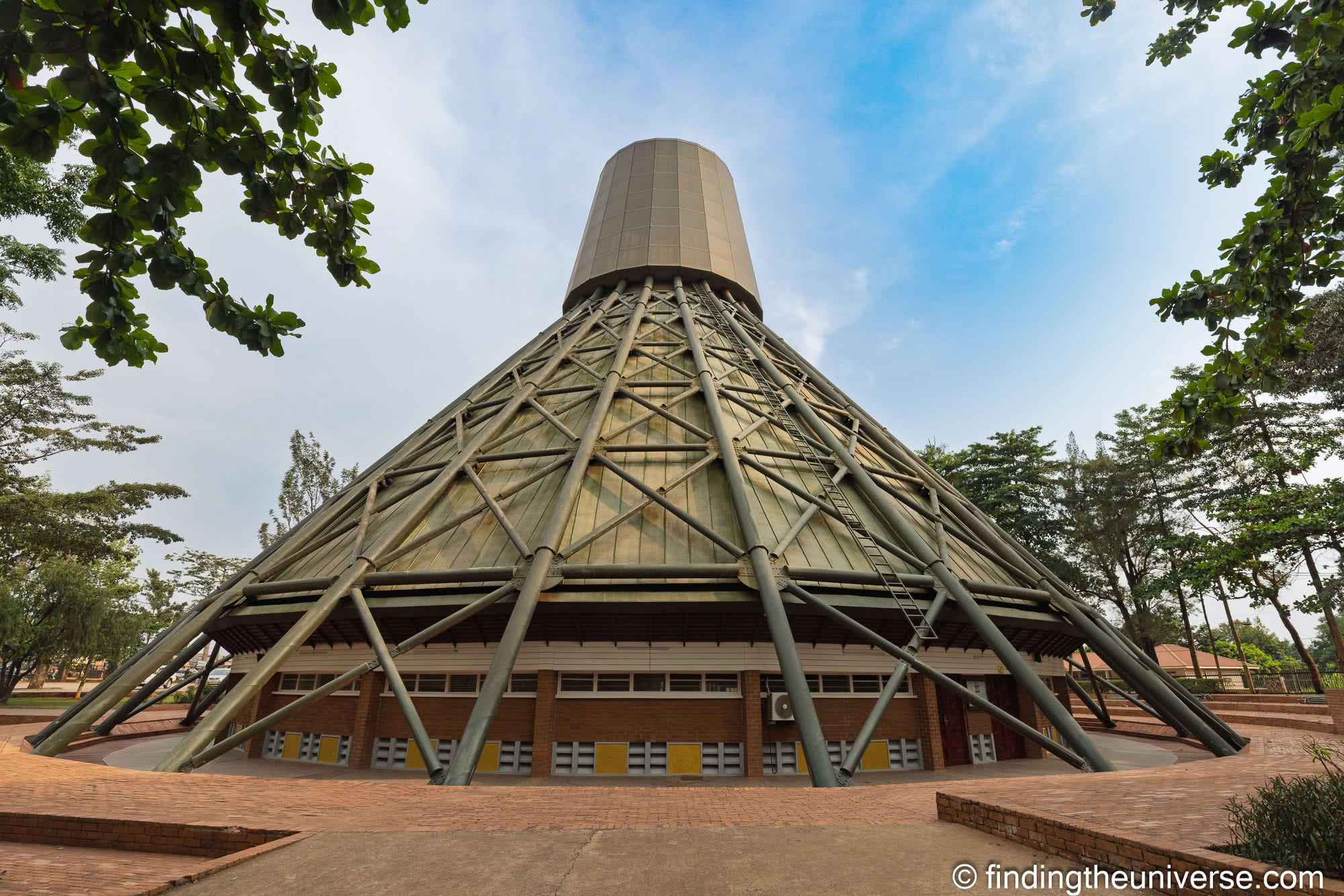

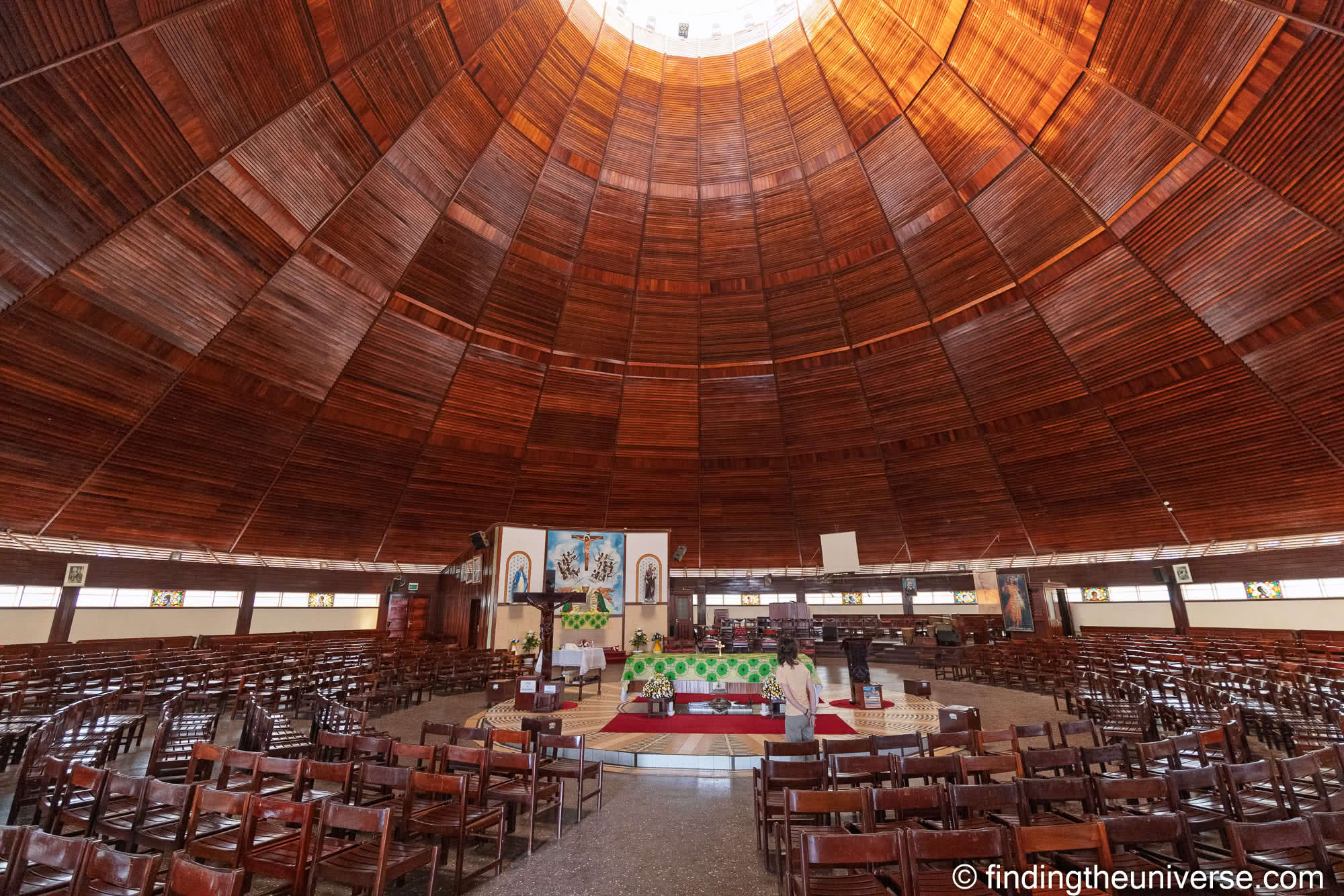

Kampala Markets
Markets are a great place to get to know the local culture and to also pick up some souvenirs from your trip. Uganda has many markets, with two of the largest being Owino Market and Nakasero Market.
Nakasero Market is the oldest market in Kampala. It’s divided into two areas, an inside and an outside. The outside area primarily sells fresh produce, while the inside area has more of a focus on things like clothing, textiles and souvenirs.
Owino Market is the largest central market in Kampala and while it sells a bit of everything, it is particularly known for vendors selling secondhand clothing, shoes, and fashion accessories.
There are of course dozens of other smaller markets in Kampala, and each area or neighboorhood will have some kind of market.
If you are specifically looking for souvenirs, then you should also consider a visit to Exposure Africa. Located on Buganda road, this market has over 30 stalls featuring arts and crafts which are generally made either in Uganda or Kenya. It has a variety of antiques, local crafts, art, and souvenirs.
We recommend visiting with a guide to get the most of your visit to the markets. They are large, busy, and can be really overwhelming for a first-time visitor. A local guide can also help you communicate with stall owners and make sure you get a fair price.
While we felt safe walking around Kampala, thieves, pickpockets, and scammers will target tourists. You also want to be very cautious of your valuables when inside the markets. We recommend that you leave any expensive jewelry, cameras, and other gear at your hotel.
Photography is often discouraged and you may be asked to stop taking photos or filming. Always ask before taking a photo of a person or their goods. Our guide asked permission of one of the market owners to allow us to take some photos from certain areas at Nakasero Market and even then we were watched and asked only to take photos from a certain place.
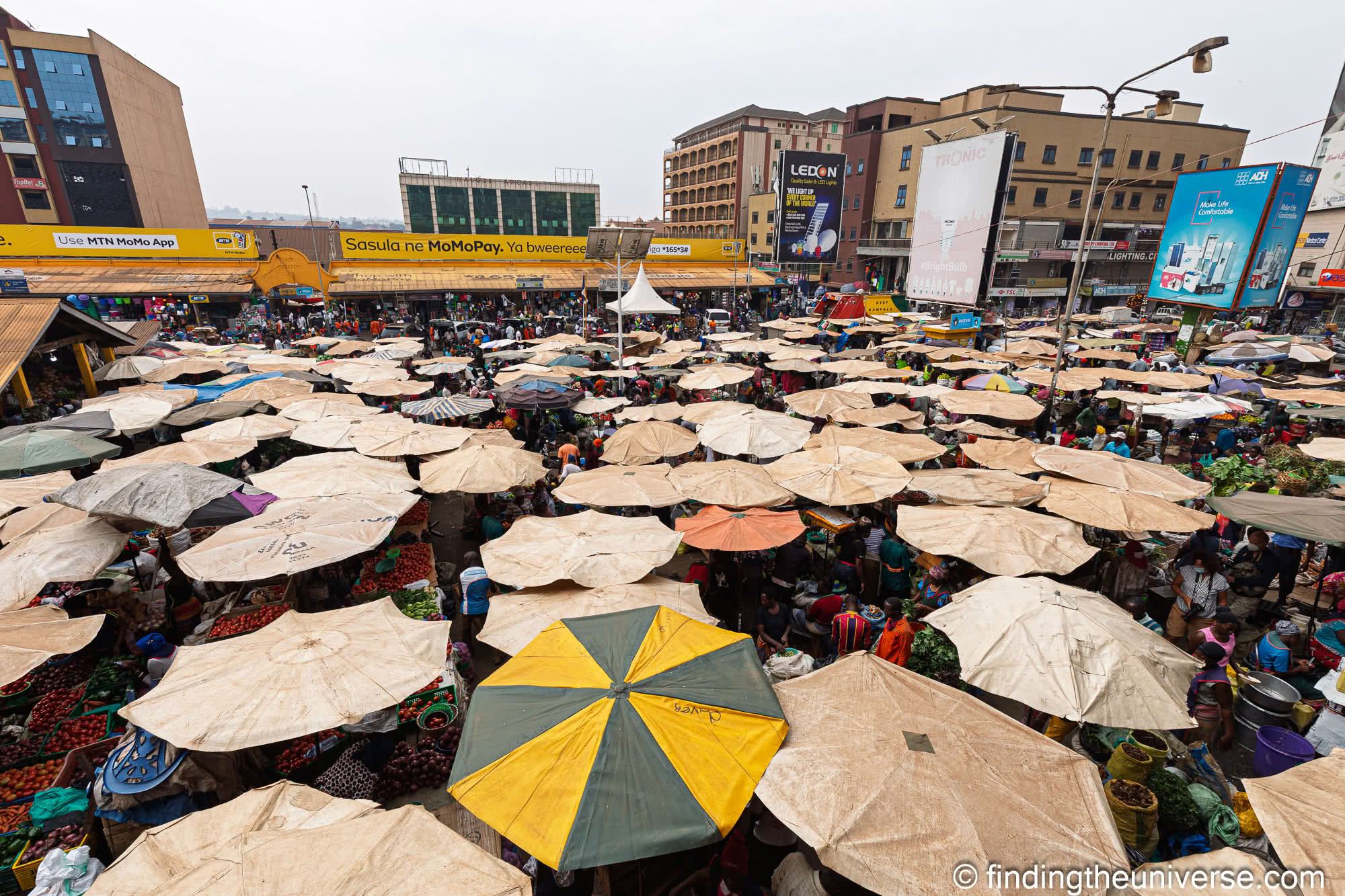

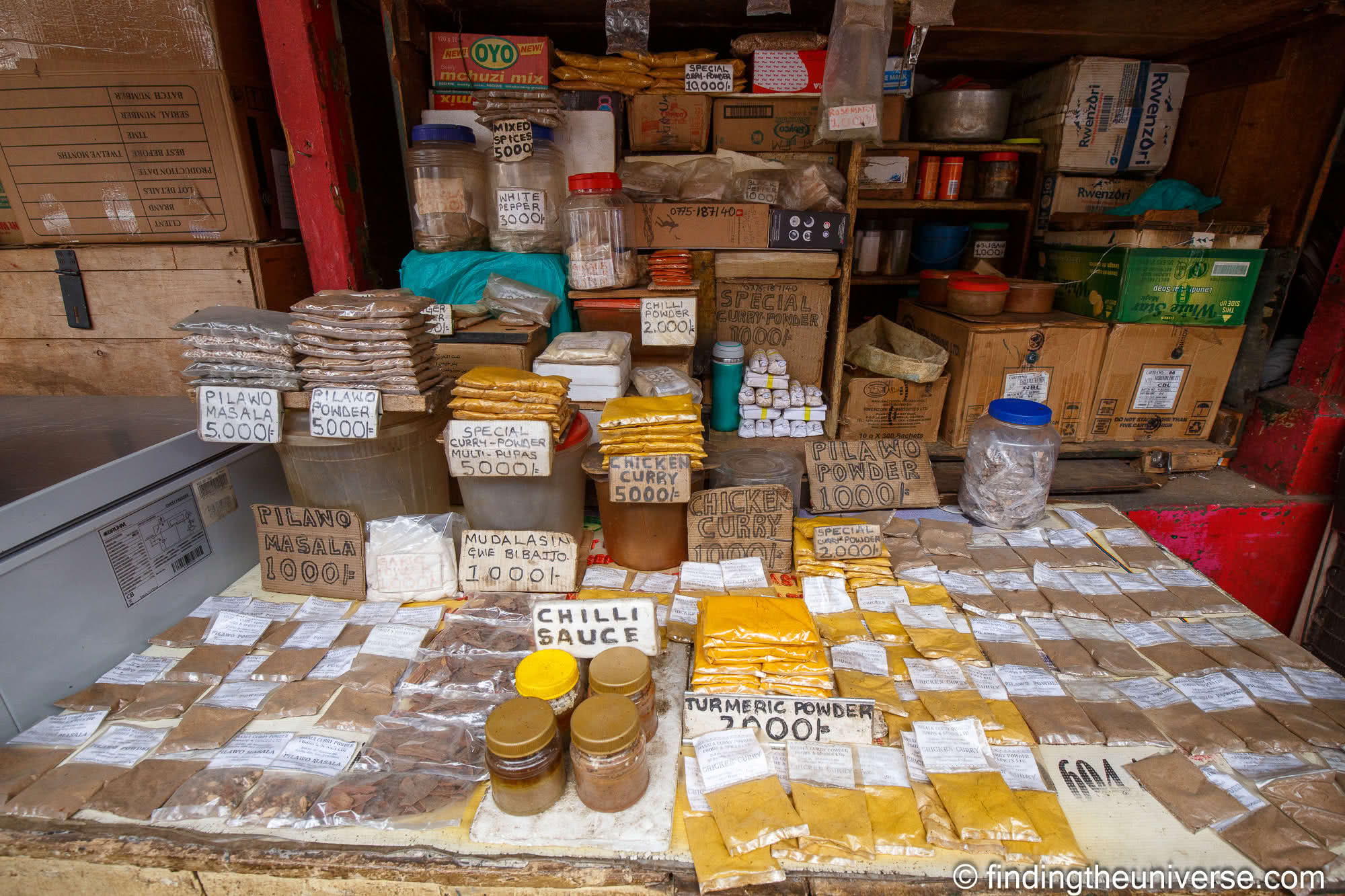

Old Taxi Park
The Old Taxi Park is the oldest and biggest transit terminal in Kampala. Here you’ll see hundreds of minibuses coming and going in organized chaos.
This is by no means a must-see place but it’s included in a lot of walking tours as a stop, and it is a good place to stop to learn about transportation in Kampala.
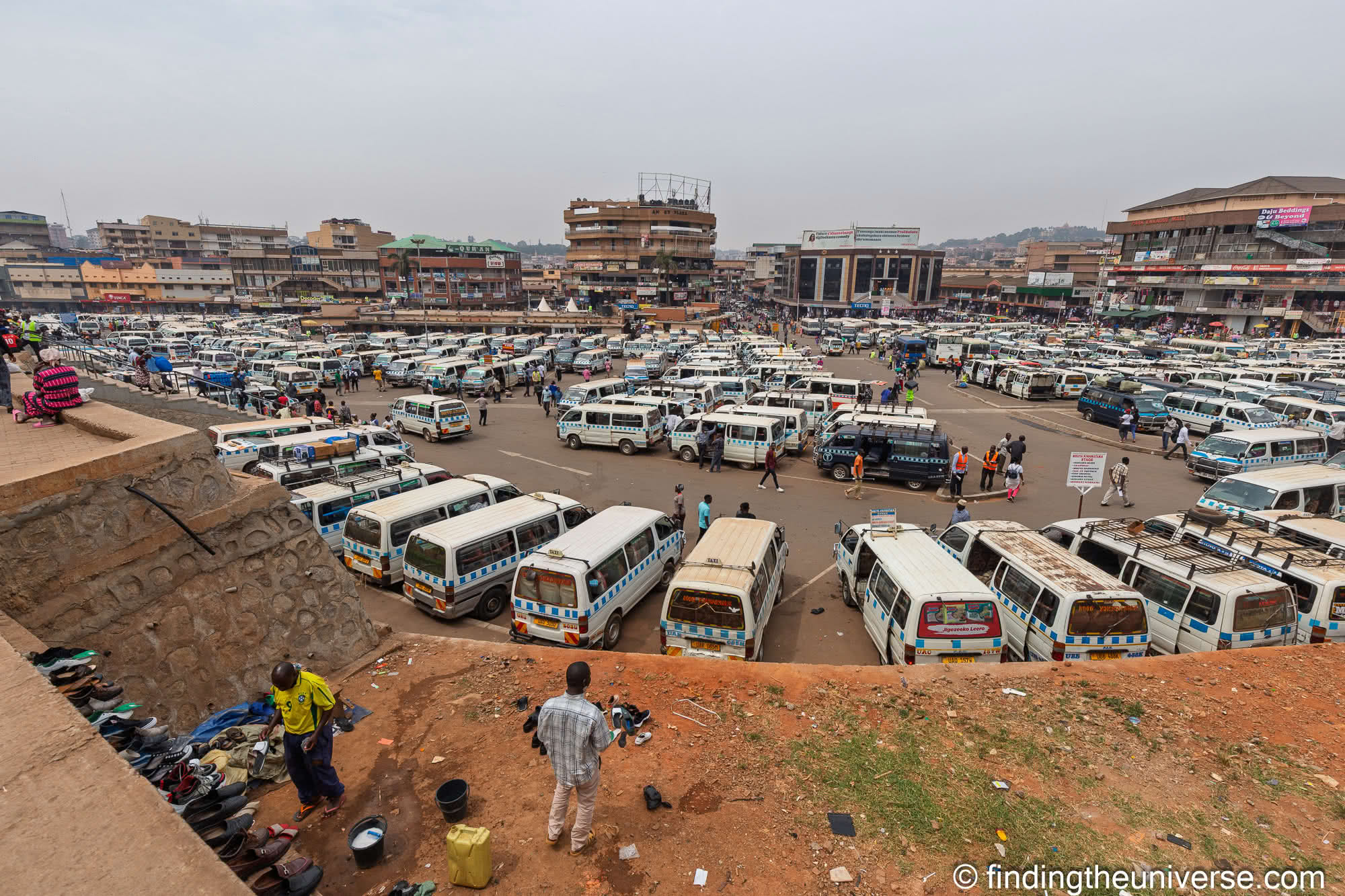

Ndere Cultural Center
One of our favorite activities in Kampala was our visit to the Ndere Cultural Center. The cultural center showcases the cultural heritage of Uganda, with dance performances, art exhibits, and food.
The Ndere troupe was founded in 1984 by Rwangezi Stephen in 1984 as a cultural organization “for universal unity through music, dance and drama”. They have now also spread that message around Uganda with traveling groups.
The main experience for visitors in Kampala, which is what we’d recommend and did, is to visit for one of the evening performances. These vary but typically include a mix of dance, theater, and music and often also have the option to have a buffet dinner during the show.
These performances take place a few times a week, and normally run from 7pm – 10pm. Shows are held outside under a large mango tree, and as well as the show there’s the option to purchase food and drinks.
We visited for the Wednesday evening Sherehe show. This was a really fun evening with great performers and a lovely setting. The show tells the stories from the different Ugandan tribes with traditional dance. There’s also an excellent and entertaining main host who explains what you are seeing so it all has context, and brings it all together.
Dinner was a buffet with traditional Ugandan food which was also good. We can highly recommended booking a ticket for a performance here if one is happening during your visit to Kampala. Its a great evening out and supporting a good local organization.
It’s easy enough to visit the Ndere Cultural Center yourself, or you can book a tour which includes a number of sights as well as the show and dinner like this one.
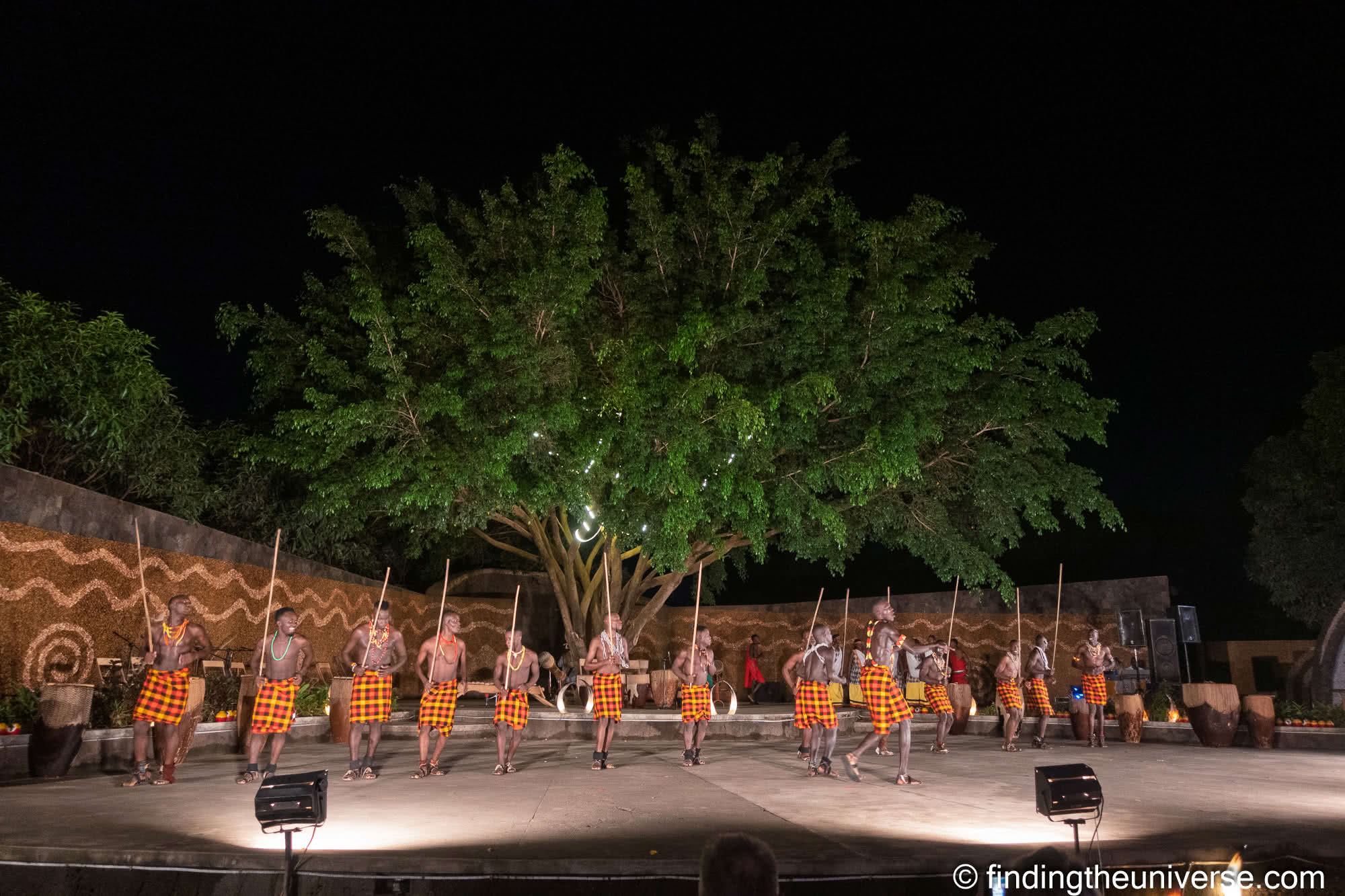

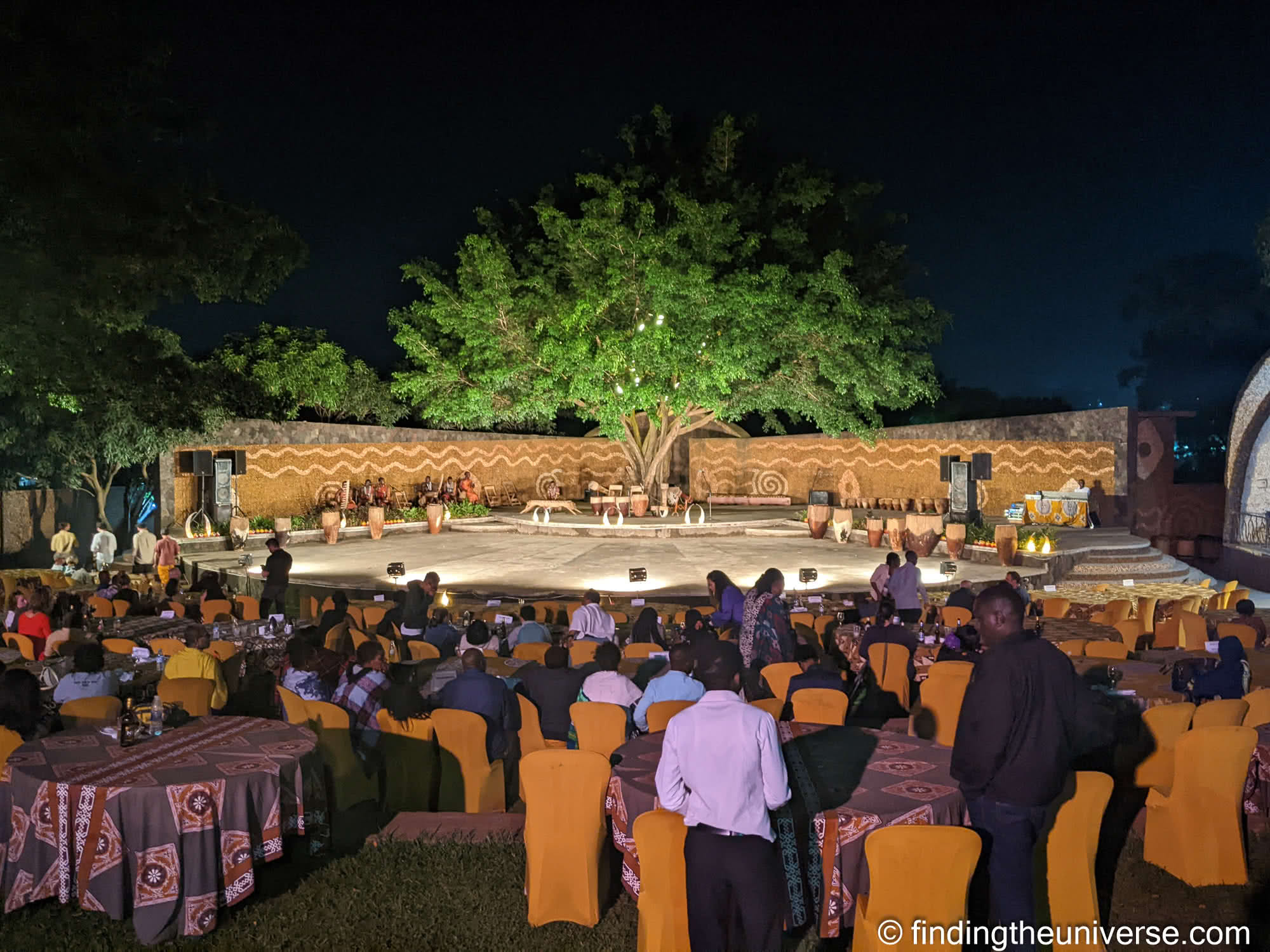

Nommo Art Gallery
If you’re interested in seeing or even buying up some local art during your time in Kampala, then a visit to Nommo Gallery is worth your time. It is a small gallery but it is one of few in Uganda.
The Nommo Gallery was established by the Uganda National Cultural Center in 1964, and can be found in the heart of the city near to State Lodge. It serves as Uganda’s National Art Gallery.
When we visited the main art exhibited was a black-and-white photography exhibition about disability. There was also a number of other art for sale, mostly paintings, but also statues, wood carvings, paper art, etc. made by local artists.
Note that getting to the gallery can be challenging. We had a taxi, but he had to drop us off about a 10-minute walk from the gallery because of road closures and security checkpoints. The gallery is located near the State House which often leads to increased security in the area. So we had to go on foot through a couple of different security checkpoints (a photo ID was required) to reach the art gallery (and then return).
Recently, there has been talk of relocating the gallery to somewhere that is easier for visitors to reach but no decision has yet been reached. In the meantime, if you want to visit be sure to be prepared and take along an official photo ID with you and wear comfortable shoes.
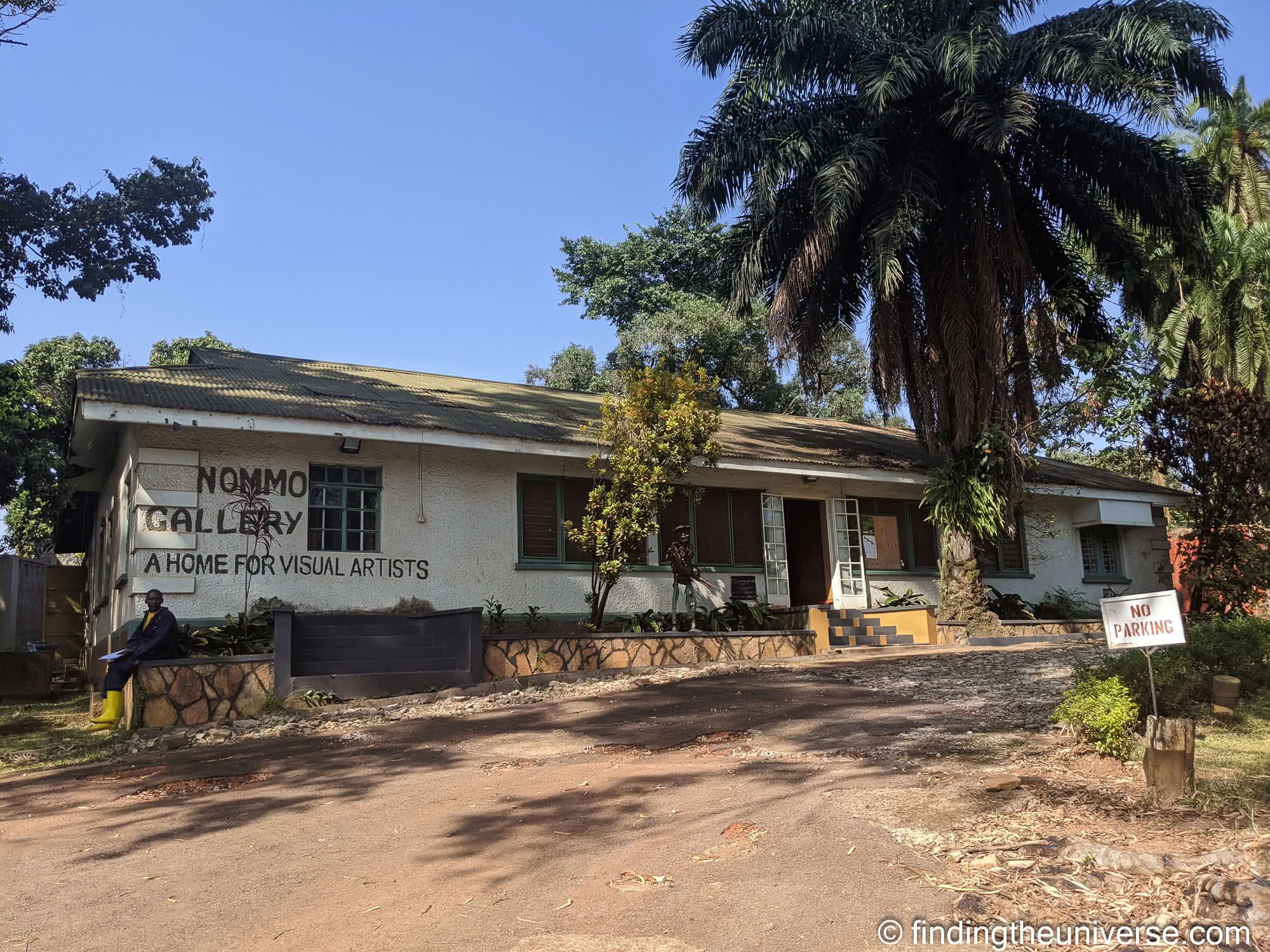

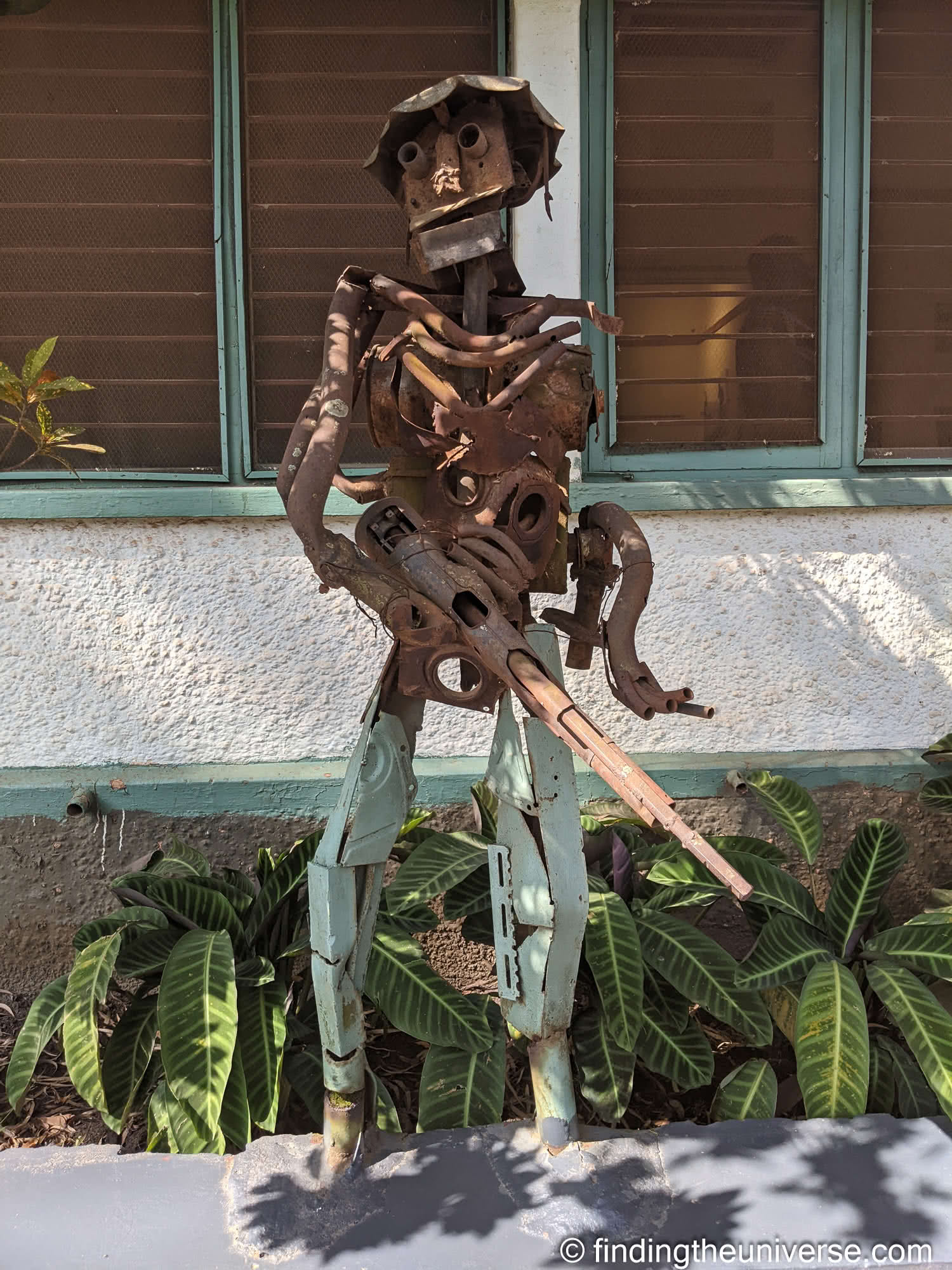

Take a Food Tour
We love exploring the local food when we visit a country, and one of the best ways we’ve found to do that is to take a food tour. On one of our visits to Kampala we took this three-hour food tour.
This was an excellent way to try a wide range of Ugandan foods, and included Rolex, deep-fried grasshoppers, fritters, fried fish, fresh fruit, sugar cane juice, and samosas from a variety of street vendors. It then finished with a full buffet at a restaurant specializing in Ugandan foods. One of the most common foods eaten in Uganda is matooke (a boiled and mashed green bananas) so I would be sure to try that.
The real highlight of the tour though, beyond the excellent food, was our tour guide Andrew. The tours are led by incredibly passionate and enthusiastic Ugandans who love to share their passion for Ugandan food and their knowledge of Kampala. We were lucky enough to be the only people on the tour, so we got to chat with our tour guide about all sorts of topics, from the political history of the country, to his favorite foods, sports, and what it’s like to live in Kampala.
If you want an immersive local experience and to try a lot of local produce and dishes, this food tour is an excellent way to do just that. This will give you a great introduction to Ugandan food.
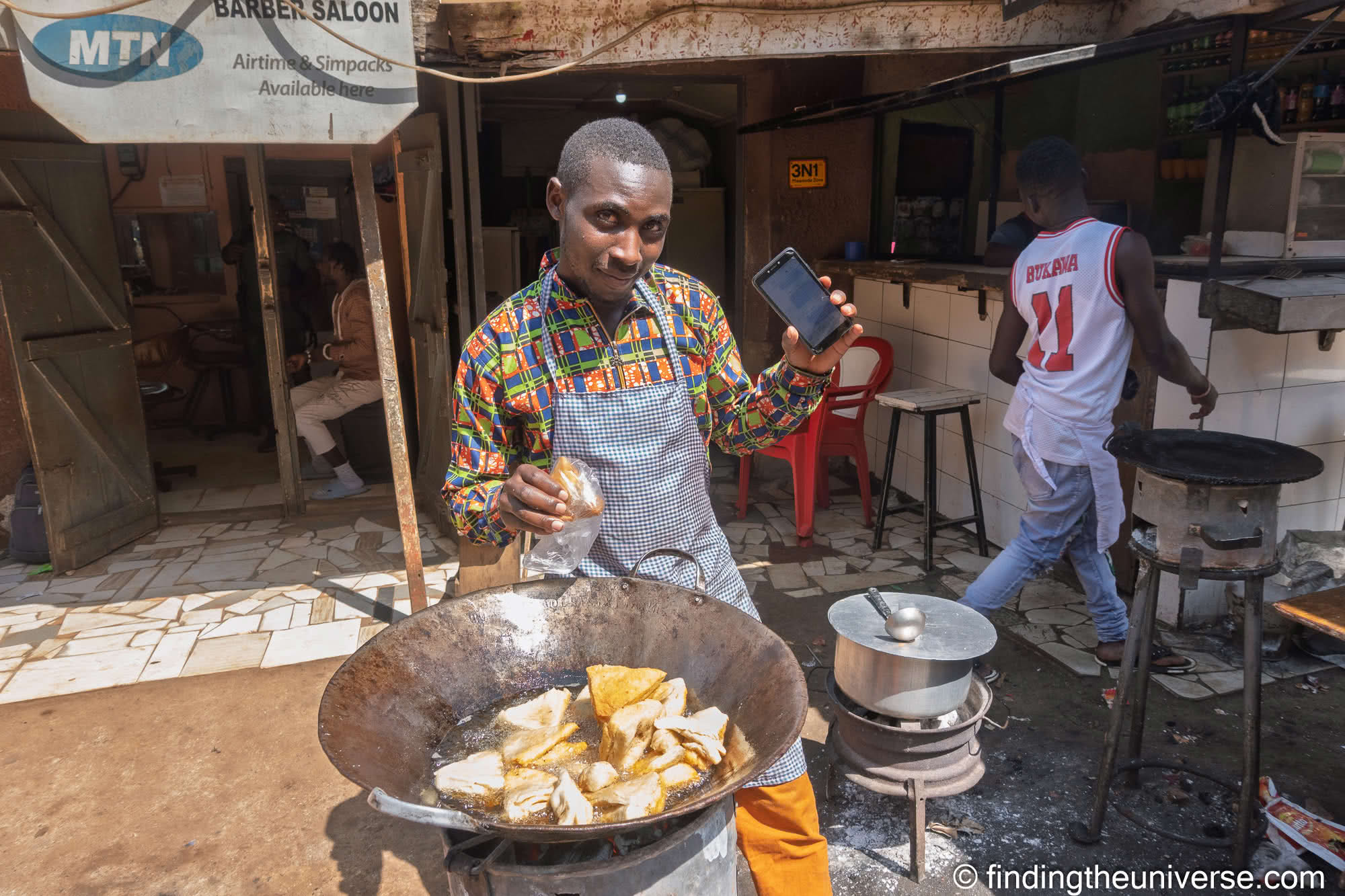

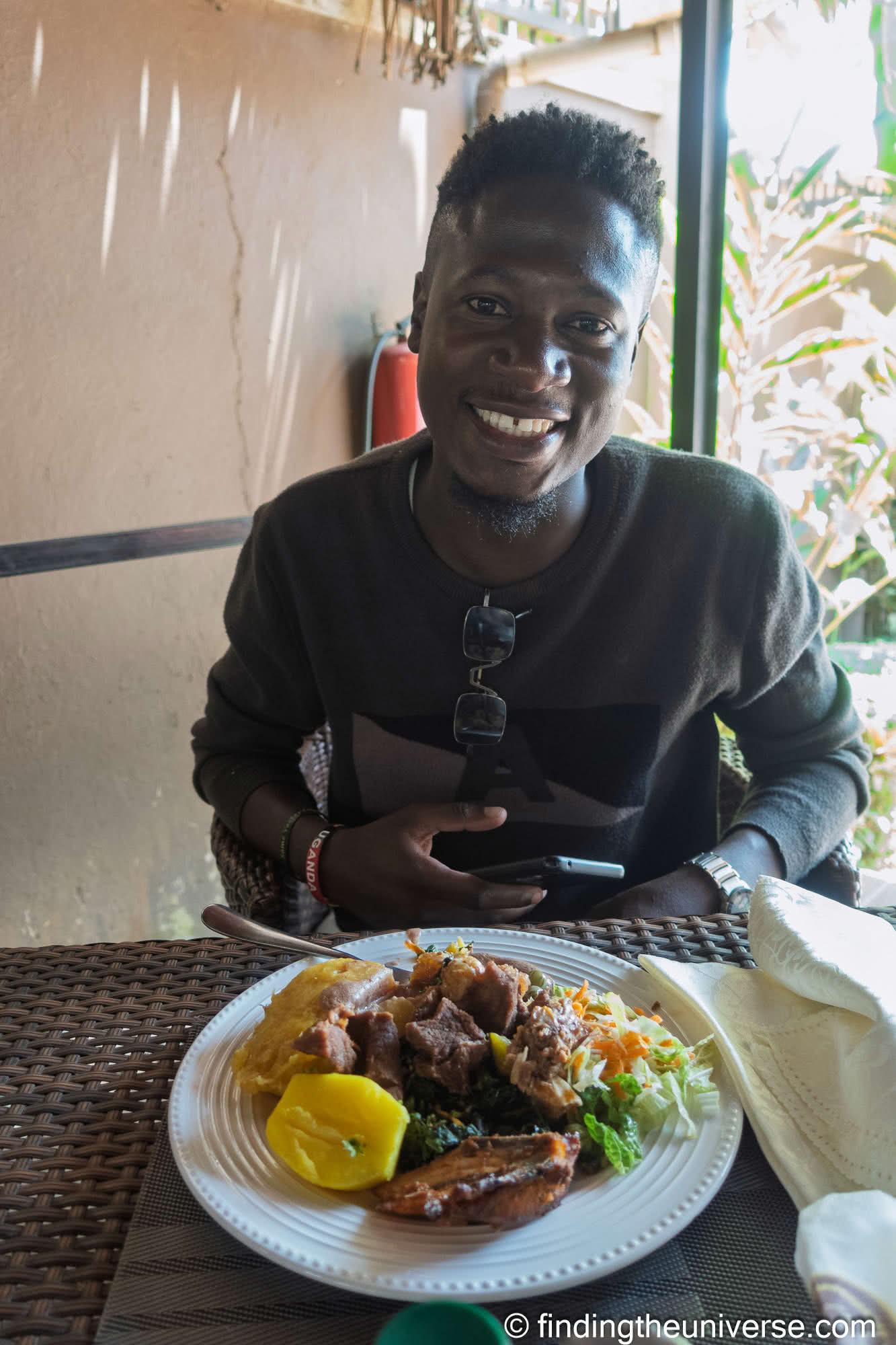

Visit AFFCAD
Like many countries around the world, poverty is a real issue in Uganda, especially affecting children. They often have limited access to everything from clean water to education to healthcare, which does not result in positive life outcomes.
One organization that is working to empower those in poverty is AFFCAD, which stands for Action for Fundamental Change
and Development. This nonprofit was set up by four young men from Bwaise in Kampala, one of the poorest neighborhoods in the city.
This township suffers from a lack of urban planning, rapid population growth, and a location on a former wetland, which all conspire to create living conditions plagued by floods and unsanitary conditions.
We recommend watching the film Queen of Katwe before your visit to Uganda to get an idea of life in the slums in Uganda, as well as learn about the amazing real-life story of Phiona Mutesi, who grew up in Katwe, and her mentor Robert Katende.
AFFCAD are working to improve opportunities available to the people in Kampala’s poorest areas, including the Bwaise neighborhood, through a range of educational, healthcare, and economic programs. This is achieved through vocational training, schools, and access to healthcare.
AFFCAD also offers a slum awareness tour to visitors to Kampala, where you can learn about the challenges facing neighborhoods like Bwaise, and understand what AFFCAD are doing to help. We have written in the past about ethical slum tourism so we definitely recommend reading that before booking any slum tours. Based on our experience, we feel that visiting Bwaise with AFFCAD definitely results in overall positive outcomes.
We took our walking tour with Jaffar, one of the four founders of AFFCAD. We visited the various AFFCAD buildings where they offer vocational training. It was not a “school” day, so it was a relatively quiet day, but we saw the various tools used for teaching skills including computers and sewing machines. The tour then took us on foot around the Bwaise neighborhood to get more of an understanding of the challenges faced by the residents.
Finally, we were served a traditional meal of kikkomondo, which is basically beans and chapati, and is delicious. A nice way to end the tour.
Our tour lasted about 2.5 hours and included transport from our hotel in Kampala. We did it in 2023 and the cost was $35 per person. We paid in cash at the start of the tour in their office.
The proceeds from the tour go directly to helping AFFCAD improve the lives of some of Uganda’s poorest, and can make a real difference. It’s also a very good way to get insights from a local about life in this part of Kampala.
You can find out more about visiting AFFCAD at their website here. These tours do need to be booked in advance. The best way to organize a tour is to e-mail them directly, which you can do at [email protected].
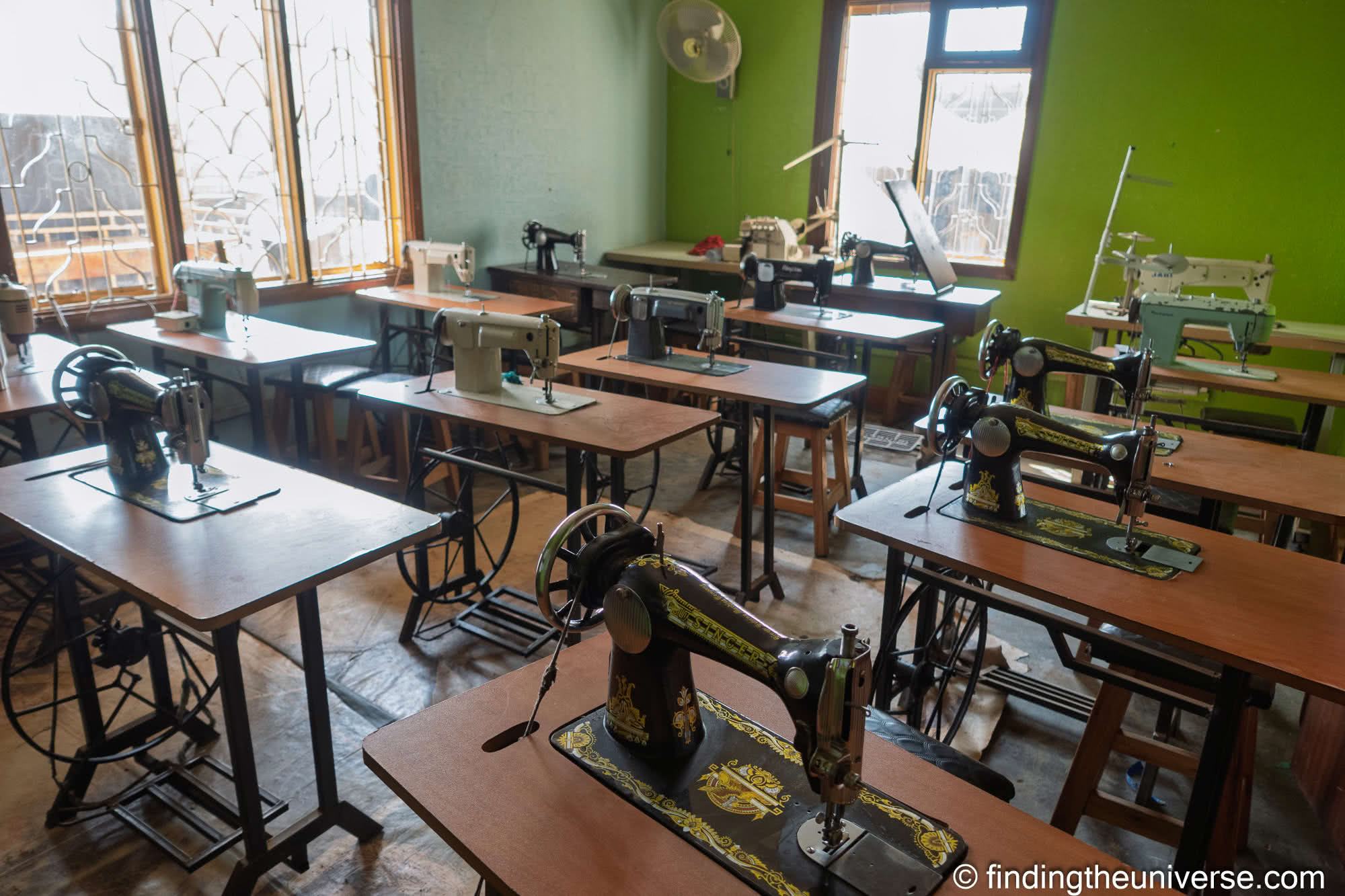

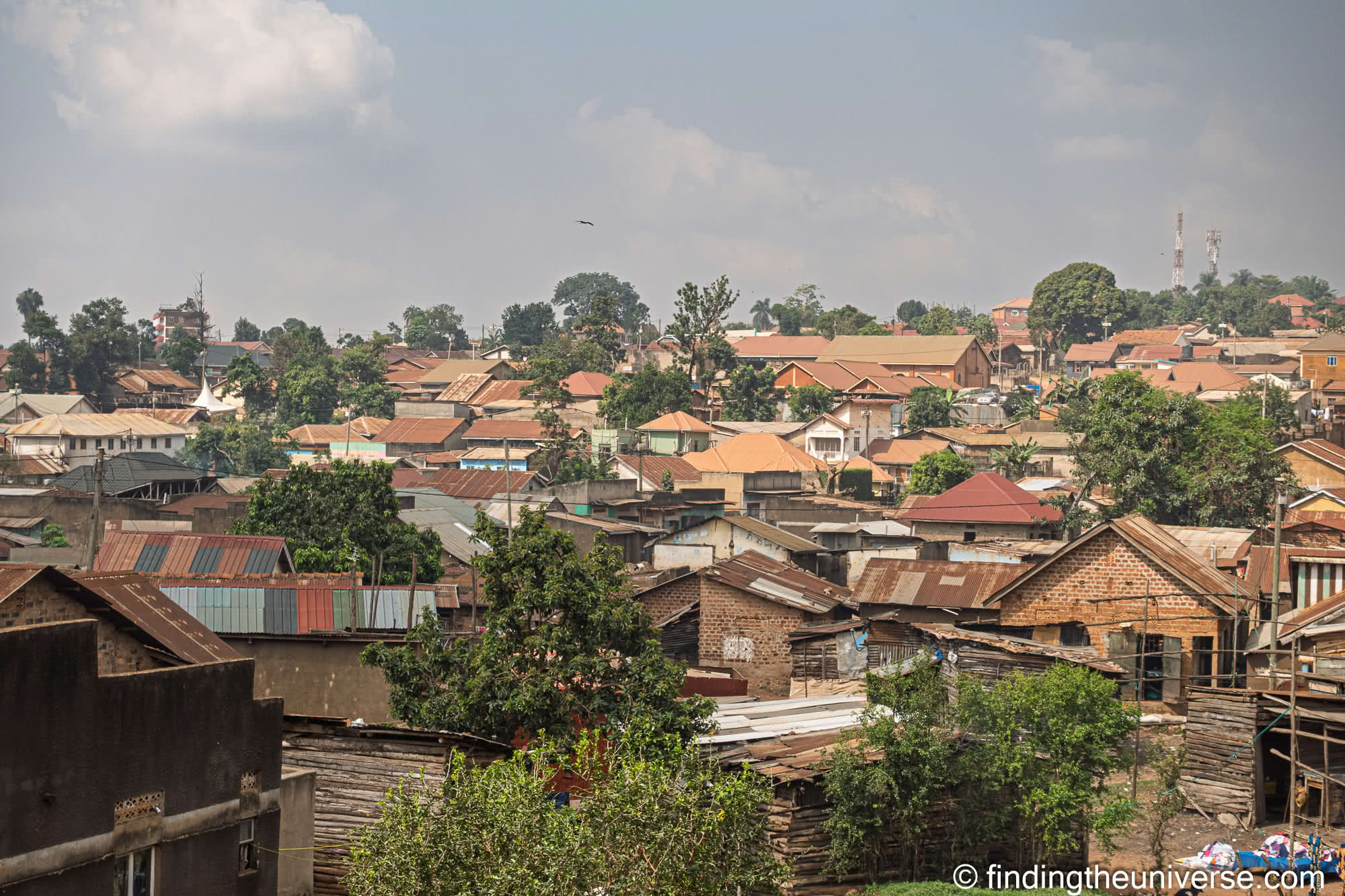

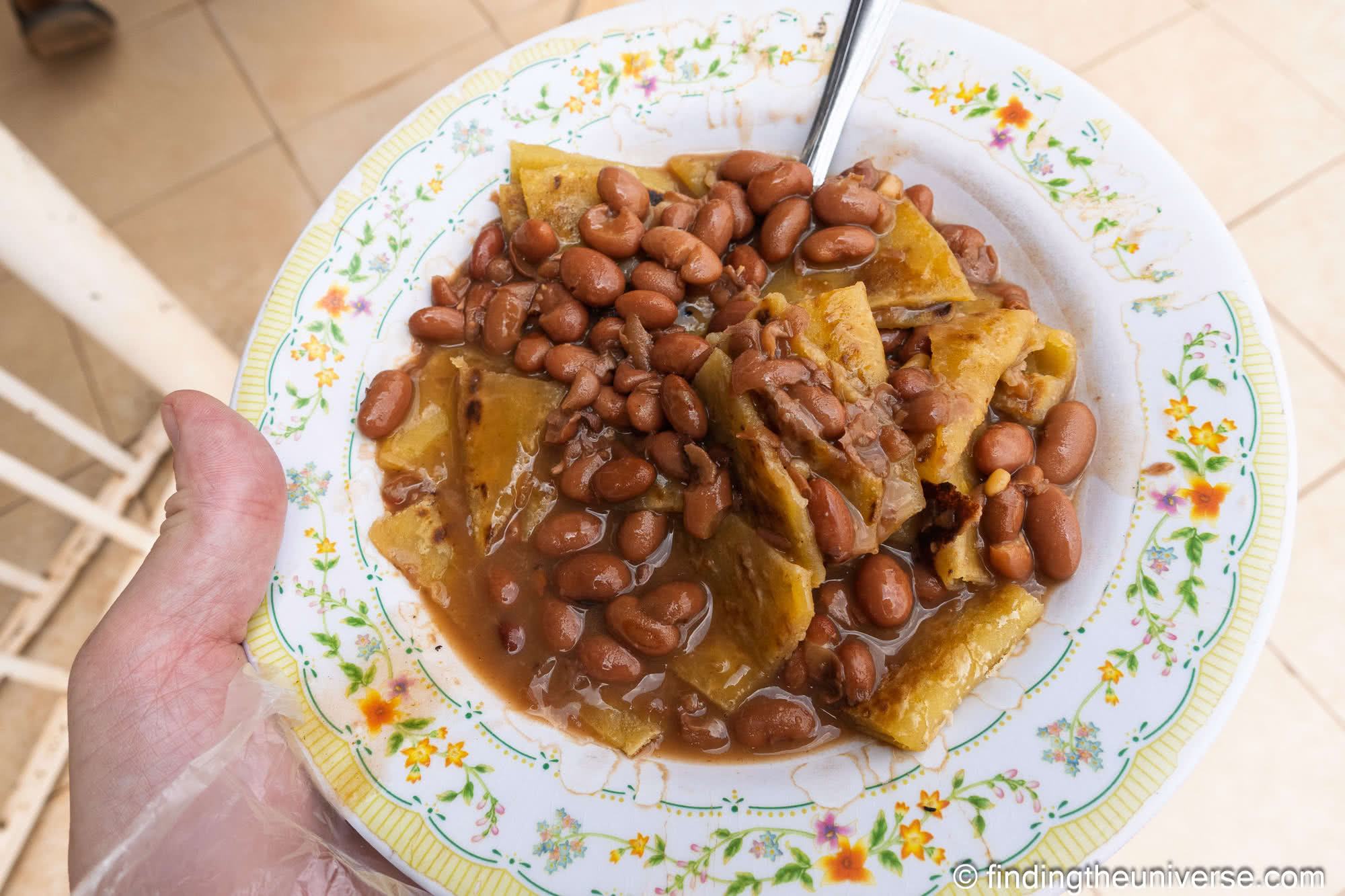

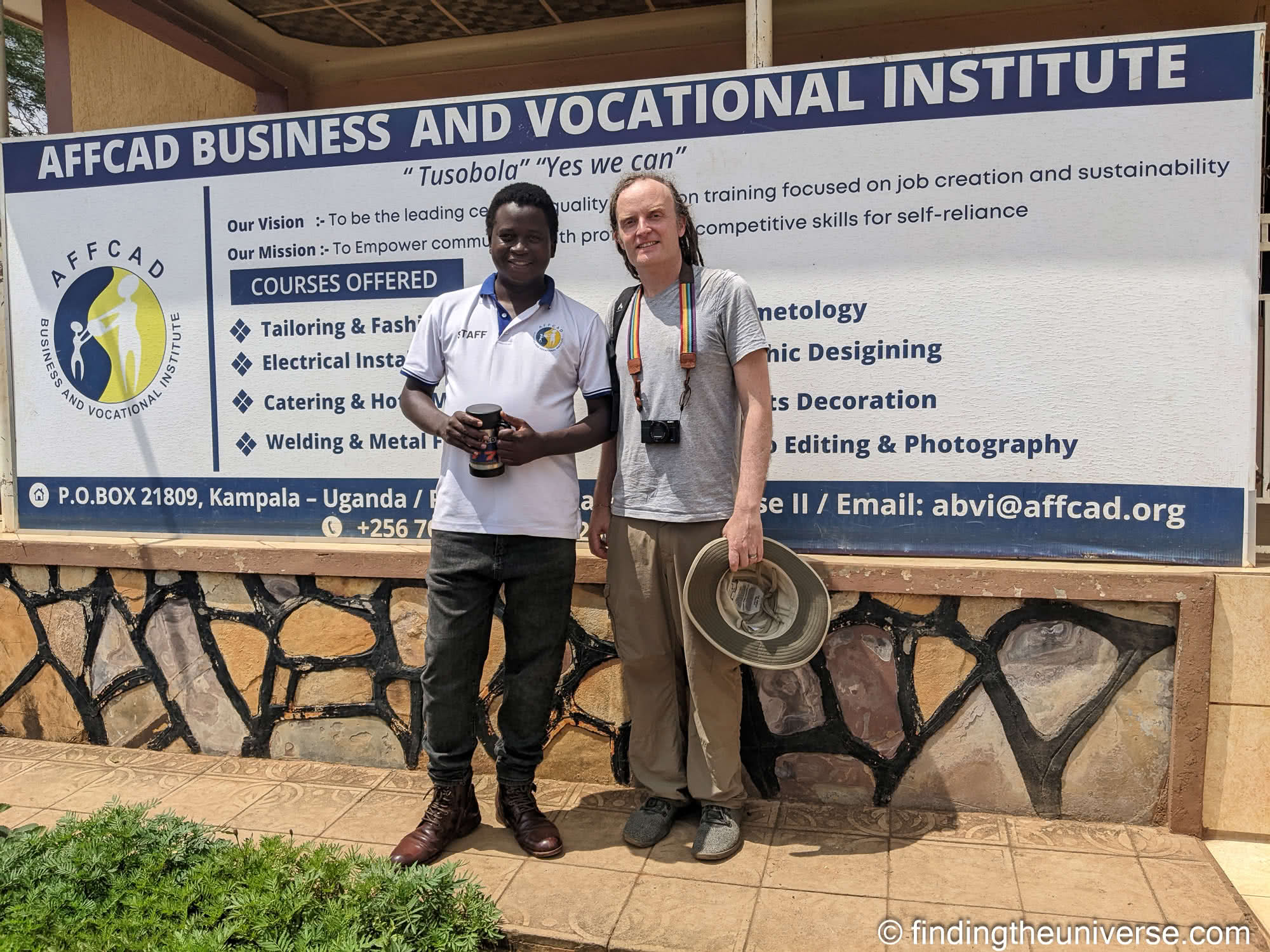

Book a Walking Tour of Central Kampala
We can highly recommend booking a guided walking tour for at least some of your time in Kampala, especially if you want to navigate the local markets and monuments, or if you want someone else to handle transportation.
Kampala can be a bit chaotic, especially for a first time visitor, and letting someone else deal with logistics and route planning will let you focus on the sights. It can also help you navigate some of the language barriers and security issues that you may come across.
We took this excellent walking tour of the highlights of central Kampala with guide Arthur who is a part of the ImmersionUG tour company. It is the top company we can personally recommend for walking tours as we have taken several walking and food tours from them during our visits to Uganda.
This company was setup by a group of young local Ugandans keen to showcase the best of their country, and we also took tours with them in Entebbe and Jinja. They also ran the food walking tour we did in Kampala. You can see more of their tours here.
The tour we did with Arthur covered some of the main highlights of central Kampala, and included sampling of a Rolex, visits to Nakasero Market, Owino Market, a Hindu temple, Parliament Square, and the Old Taxi Park, a local coffee at the 1000 Cups Cafe, and time at some of the monuments in Kampala including the Independence Monument. We also took the option to visit the Uganda National Mosque.
Overall, we can highly recommend booking a walking tour of Kampala as part of your visit to the city. Ideally we recommend doing something like this at the beginning of your time in Uganda as it helps give you a good introduction and a chance to ask a lot of questions.
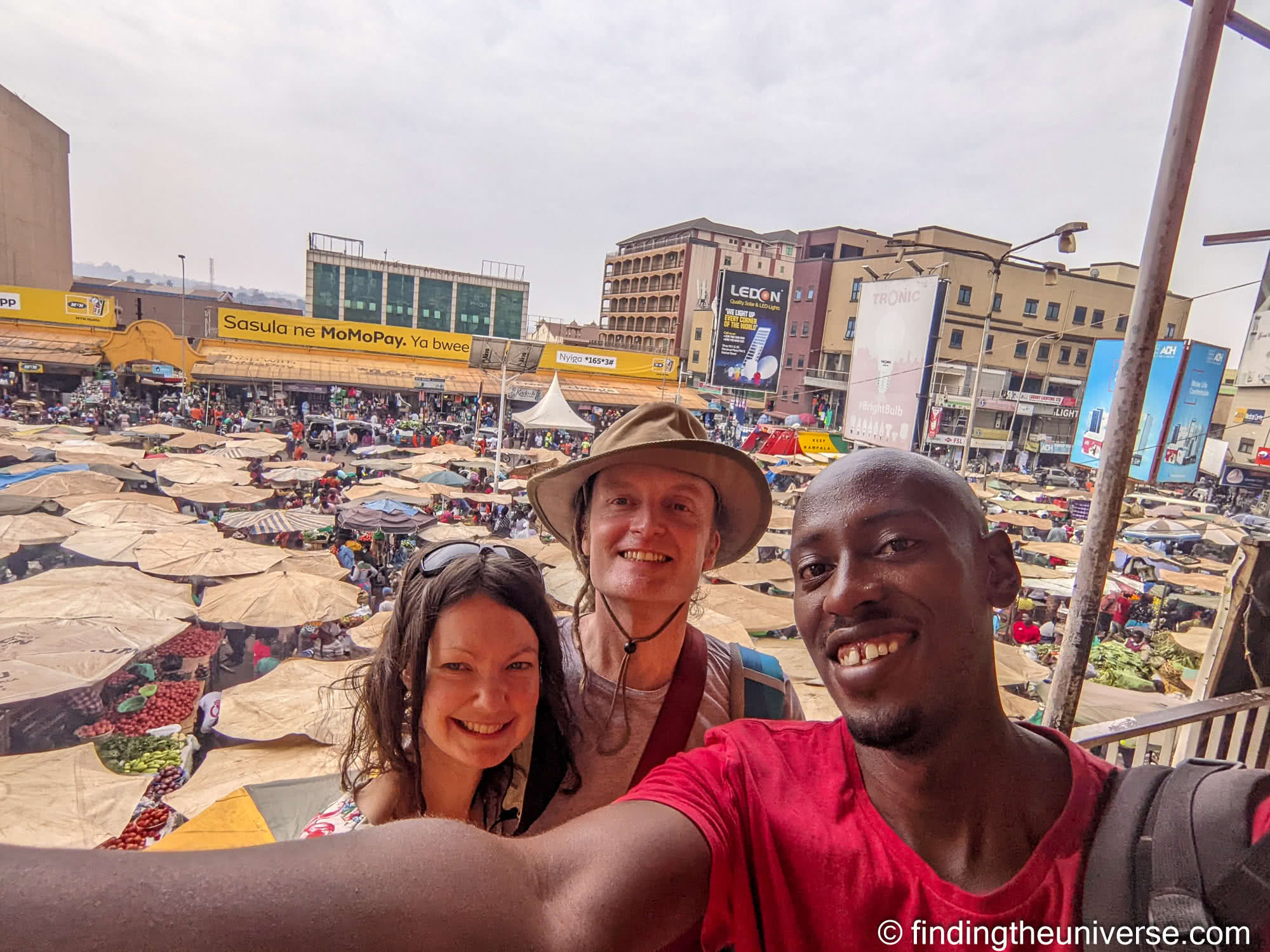

Day Trips and 2-Day Trips from Kampala
Obviously, there is lots to do in Kampala itself, but if you are in the city for a few days (perhaps as part of a conference or something), you might be wondering what options there are for exploring further afield.
The good news is that there are lots of good day trip options from Kampala, as well as options for 2-day trips. Most of these can be done as part of a day tour. Here are some to consider:
- A day trip to Jinja and the source of the Nile. Jinja is a relatively laid-back city on the shores of Lake Victoria, around a 2-hour drive to the east of Kampala. It’s noted as being regarded as one of the sources of the River Nile, as this is where Lake Victoria starts to feed into this mighty river. A tour from Kampala is a good way to see the sights of the city in a day.
- Entebbe day trip – Most visitors to Uganda will pass through Entebbe as this is where the international airport is located. It’s only about half an hours drive from Kampala and can be easily reached with a ride-share or shuttle bus service. There’s lots to do here on a day-trip, including visiting the zoo and the botanical gardens. See our guide to Things to do in Entebbe for some ideas.
- Visit the Chimpanzees at Ngamba Island. Chimpanzee trekking is a popular activity in Uganda, but the majority of the chimpanzees are too far away from the capital city to make a day trip feasible. However, there is a population of chimps on Ngamba Island on Lake Victoria. This tour includes round-trip transport from Kampala with a boat-cruise, as well as a guided chimpanzee trek, snacks, and lunch. Note that is is also the best place to see chimps in Uganda if you have children as all other sites have minimum age restrictions.
- See the shoebill storks at Mabamba Swamp. One of our favorite experiences in Uganda was our boat birding safari on Mabamba Swamp to see the awesome looking shoebill stork. These birds have an incredible shovel shaped beak, and are only found in a few locations in Uganda. The boat tour also includes the opportunity to see many other birds, but the shoebill stork is the highlight.
- A day trip to the Ziwa Rhino Sanctuary, which is currently the only place to see rhino in Uganda. Includes round-trip transfers and admission to the park. We’ve visited Ziwa twice and have always gotten to see rhino, a more remarkable experience because you actually trek and find the rhino on foot. You will also likely see a lot of birds and other wildlife as well here. Highly recommended.
- If you really want to go on safari in Uganda but don’t have a lot of time to spare, then consider this 2-day overnight trip to Murchison Falls. It is around a four hour drive each way, but you will still have time to see the impressive Murchison Falls, take a boat ride, and do a morning game drive. There’s also the option to include a stop at Ziwa Rhino Sanctuary.
- There are also many multi-day safari focused tours from Uganda, including tours which feature chimpanzee trekking and gorilla trekking. You can see some of the best options on GetYourGuide here and Viator here.
There are of course many more options for trips from Kampala, especially if you have more time. You can see a range of options here. The only thing we’d always recommend is to check driving distances. Uganda is fairly large, and you don’t want to spend all your time just sitting in a vehicle getting from Point A to B.
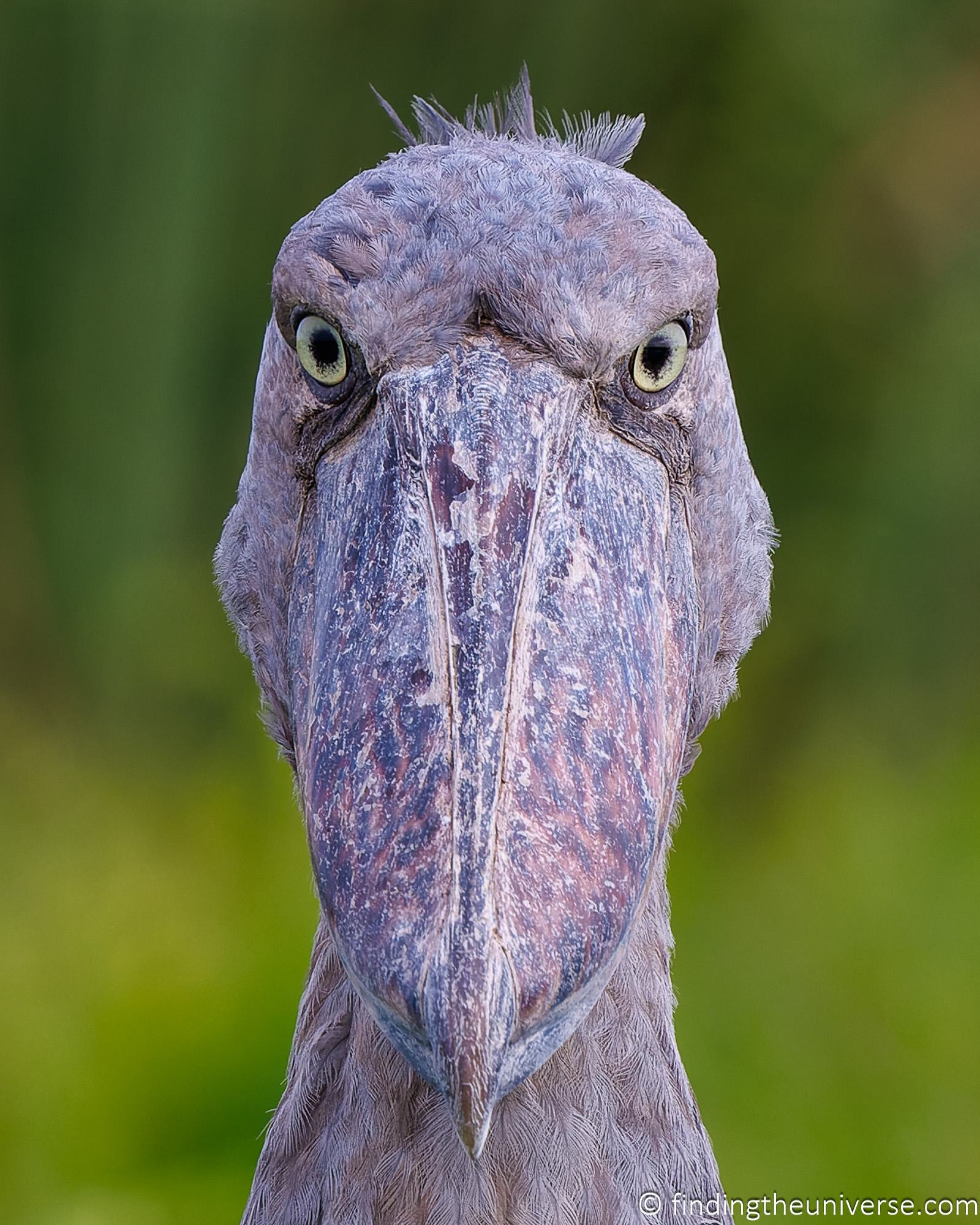

Practicalities for Visiting Kampala
How to Get to Kampala
As the main city in Uganda, Kampala is well connected to the rest of the country by road. The main airport in Uganda is in nearby Entebbe, with an express highway between the two, which only takes around 30 minutes to travel by car. Note this is a toll road, but the fee is well worth paying as the old Entebbe-Kampala road can take over 2 hours to traverse due to traffic.
If you are arriving into Entebbe airport and staying in Entebbe or Kampala, your hotel might be able to arrange an airport transfer for you. You can also book this yourself using a service like this.
There is also a shared shuttle bus service from Entebbe to Kampala and Jinja known as the Pineapple Express. This offers an affordable scheduled service from a number of Entebbe locations including the airport, and you can book this online here.
How to Get Around Kampala
There are a number of different ways of getting around Kampala. The city and its attractions are quite spread out, so whilst you can walk to see some attractions, it’s likely you will need some form of transport during your visit.
There are a number of options, including motorcycle taxis (boda boda), minivan taxis (matatu), ride sharing apps like Safe Boda and Uber, as well as private drivers and tour companies. You could also rent a car and drive yourself, although given the traffic and some of the road conditons we’d probably advise against that.
As an international traveler, your two main options for quick travel are to either use a car (either a private taxi or via ride sharing app) or to get a boda boda. The boda boda is definitely the fastest and cheapest option of the two and if you need to get somewhere quick, these are often the only option. They can be hailed from almost any street. But we stuck to cars because there was the two of us and we felt more safe in cars.
For the majority of our Kampala sightseeing we used a ride-sharing app (Uber) to get around the city. This made things easy as we could pay via the app. However, we did have issues with drivers not really knowing how to use the app correctly or still asking us to pay in cash (we would refuse and still pay via app). So just know many drivers are new to Uber so there can still be issues.
Another popular option is SafeBoda, which allows you to specify if you want a car or a boda boda (motorbike). If you do want to take motorbike taxis, we do recommend booking through them as you can pay via the app and they include a helmet and safety vest.
For some of the sights we visited they were close enough to our hotel that we visited them on foot. So walking is an option, just be sure to wear comfortable shoes you don’t mind getting dirty (our shoes got a nice layer of reddish brown dust from our walks).
On one of our later visits to Kampala we walked out a lot, enough so that the local security people in the area would say hello to us and eventually stopped asking if we wanted them to call us a taxi. While we felt safe wandering around on foot, it may not feel comfortable or be a good option for some people as you will likely draw attention. We only walked during daylight hours, and would not recommend walking on your own after dark.
Of course, if you are doing a tour that includes transportation in Kampala (or part of a much bigger Uganda tour), then that is also a popular way for visitors to get around. On our first visit to Kampala, our driver just dropped us off and picked us up at designated places, making it very easy.
If you are visiting on your own (without a tour guide), just know it is not that hard to get around Kampala on your own. If you have any questions or need help getting a taxi or boda boda, your hotel can easily help you arrange this.
Where to Stay in Kampala
There’s a wide range of hotels to stay at in Kampala, across various price points. Here are some options to consider, including the hotels we’ve stayed at during our time in the city.
- Bushpig Backpackers – if you’re looking for a hostel in Kampala (or just a budget friendly lodging option), then this is an excellent choice. Both private rooms and shared dormitory rooms are available, and it’s just a short walk from the Uganda Museum. There’s also an on-site bar and restaurant where the included breakfast is served.
- ONOMO Hotel Kampala – we’ve stayed here twice and had a comfortable stay each time. This is one of the newer and more modern hotels in Kampala. There’s free WiFi, comfortable air-conditioned rooms, a pool, an on-site restaurant, and excellent buffet breakfast.
- Humura Resorts – we stayed in this lovely relaxing boutique hotel on our first visit to Kampala. Rooms are very comfortable and offer air-conditioning, and there’s an on-site restaurant and pool. It’s a very peaceful place that offers an oasis of calm away from the bustle of the city.
- Kampala Serena – we have stayed in a number of Serena properties and always had a good stay, so we are happy to recommend this 4* hotel. Featuring a large swimming pool, air-conditioned rooms, and on-site restaurants, this hotel would make a great base for exploring the city
- Sheraton Kampala – This 5-star Sheraton hotel is another luxury option found in the city center right next to the Independence Monument. It has a pool, a number of restaurants, comfortable air-conditioned rooms, a fitness center, a sauna, and a beauty salon.
Of course there are many more options across Kampala, you can see a complete range of properties at varying price points on booking.com here.
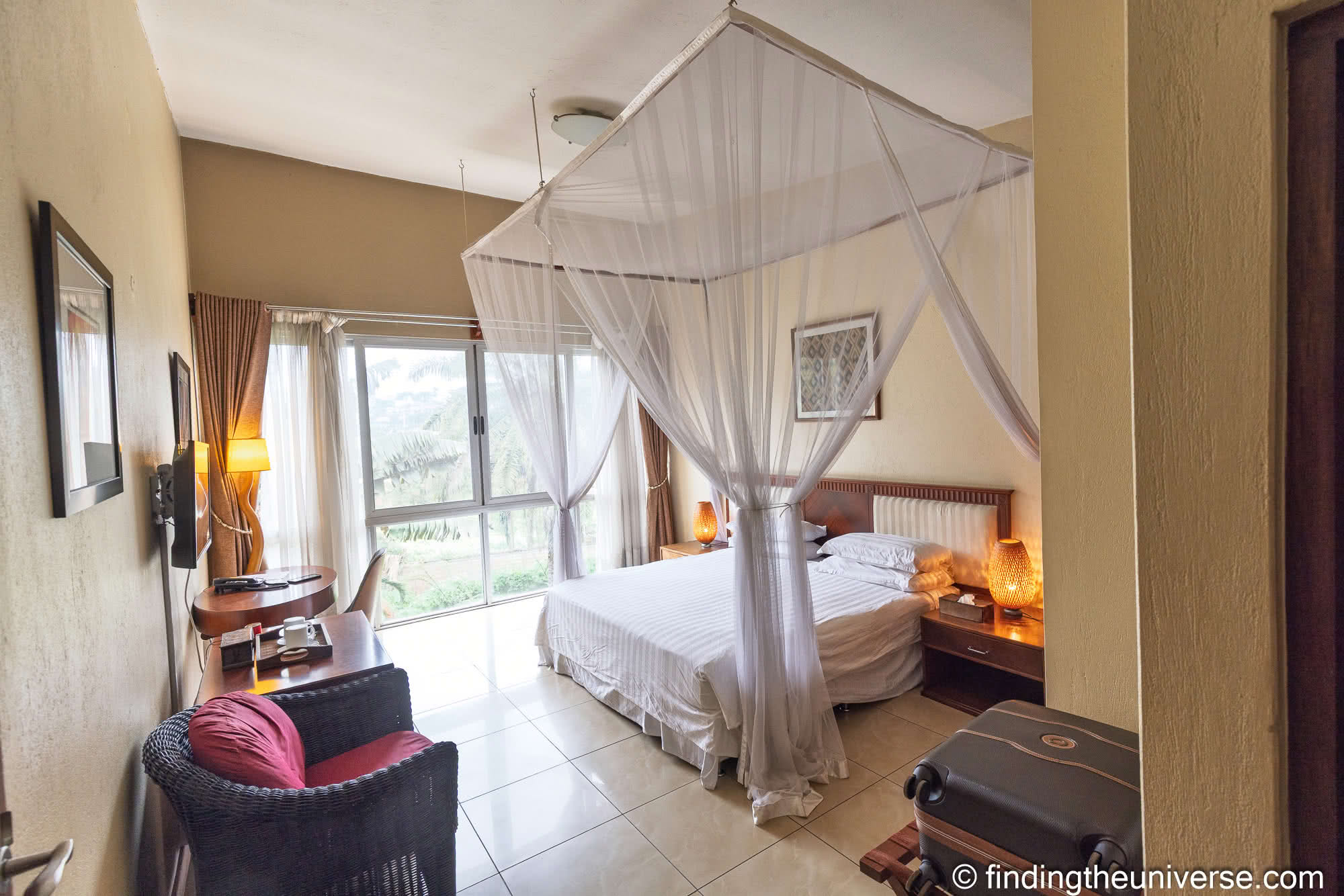

Safety in Kampala
A lot of people ask is Kampala safe? This is impossible to really totally answer but it is safer than many other African cities but it does have its share of violent crimes, petty crimes, risks of terrorism, and health threats.
That said, we have personally felt pretty safe in Kampala as foreign visitors on our four visits to the city. But you do need to take normal precautions for traveling in a large city.
The main risks most tourists will face in Kampala will be pickpockets and thieves. Keep in mind that a $1,000 camera or smartphone may be normal to you but may mean a whole lot to someone living on a few dollars a day. So, you will want to be vigilant with your valuables and carry a minimal amount of money on you.
The risk will likely be higher in busier areas like crowded markets, or on a public bus. Keeping any valuables like expensive jewelry, watches, smartphones, or cameras out of sight is a wise idea. If you don’t need them, I’d keep them in the hotel. You’ll probably notice in some of the photos that even as a photographer I left my big camera at home most days and just carried a little compact camera with a thick neck strap.
A money belt, such as this Eagle Creek one (which is the one we own), is a good way to store money, credit cards, hotel key, passports, etc. You will want to ensure anything that can be snatched is secured, so for example a cross-body purse or camera strap that goes around your neck is going to be better than having something slung over a shoulder that can be more easily taken. If you choose to wear a backpack, make sure the closures/zippers can be secured.
Having a guide or joining a tour will help reduce your risk; however, note you still need to be vigilant even with a guide as they can’t always be watching you and your valuables.
If you choose to rent a car (not recommended for most people), avoid leaving valuables in your car and park it in a secure spot at night.
As with anywhere in the world, the risk increases at night, and it’s generally best to avoid walking alone at night in most areas. Taking a ride-share as part of a group, or just traveling with a private guide, is likely going to be safer.
A special consideration for travel to Uganda should be made for LGBTQ+ travelers after the passing of the May 2023 Anti-Homosexuality Act. According to the U.S. Department of State, LGBT persons (or persons perceived as such and those promoting LGBT issues) are at increased risk for fines, violence, harassment, imprisonment, and can even face the death penalty.
Language in Kampala
The official languages of Uganda are English and Swahili; however, there are a lot of local languages spoken in Uganda.
The most widely spoken language in the area is Luganda. Luganda is the language of the Baganda people (Kampala is part of the Buganda region, the largest of the traditional kingdoms in Uganda).
Although Swahili has been made an official language, we rarely heard locals speaking it unless speaking to visitors from other East African nations. Some told us they prefer not to speak the language as it reminds them of the time of Amin and military violence. However, it is the language they share with most of the rest of East Africa.
As a tourist in Entebbe and Kampala, you can get by pretty well with English as most people in the tourism industry here speak at least some English. At attractions and museums, the information is often written in English.
If you don’t speak English, Swahili, or a local language such as Luganda, you should consider hiring a guide or translator to get the most of your time in Kampala. Or at least bring a good written guidebook with you.
Currency in Kampala
The main currency in Uganda is the Ugandan Shilling, or UGX. This is accepted everywhere.
The US dollar is also generally accepted, but you should be aware that they need to be recent bills in very good shape. Any kind of marking or damage to the bill means it’s unlikely to be accepted due to a fear of the bank not accepting it. We had this happen a number of times in Uganda (and other African nations). So it’s generally easier to just find an ATM and withdraw UGX.
Credit cards are also accepted at most hotels and larger restaurants, but this is not universal, so it’s best to always carry some currency with you.
Health in Kampala
As with many countries around the world, you will want to take some precautions to ensure you stay healthy as a visitor to Uganda.
Before you visit you will want to ensure you are up to date on any vaccinations you need. You should also discuss any current recommendations for travel to Uganda, which will likely include anti-malarial medication.
You can get malaria in Kampala although the risk is lower than in most other parts of Uganda. Note that in addition to malaria, mosquitoes can carry and transmit a number of other diseases so prevention is key (insect repellent, wearing long sleeves and pants, etc.)
We also highly recommend reading the health advice given by your local government for travelers to Uganda. You can see the U.S. CDC travel health information and recommendations to travelers here, and from the UK government here.
Reading the health warnings issued by governments can be a bit scary as there have been outbreaks of some pretty serious things like ebola, mpox (monkeypox), cholera, and yellow fever in Uganda. But just know that these are generally small outbreaks and you are not likely to come into contact with them as a tourist. But you should still be knowledgeable and take necessary precautions.
The main health issue most travellers are likely to face is going to be an upset stomach. This can be caused by a variety of things, but is most often caused by eating or drinking something with contaminated water.
When it comes to water, you will want to stick to filtered, treated, or bottled water. You’ll also want to avoid fresh salads, uncooked vegetables and fruits (unless you can peel it), unpasteurized milk, cooked foods that are not served hot, etc. unless you know they are from a reputable and licensed food vendor (such as your hotel restaurant).
If you’d prefer to avoid buying bottled water in Kampala, you can read this article on safe drinking water when traveling for ways that you can treat water when traveling. We used a Grayl water filter bottle for filtering tap water for drinking, cooking (e.g, washing fruits), and brushing our teeth while in Kampala on our last trip. This made it so that we didn’t need to buy any bottled water.
For food, it’s best to try and eat at reputable establishments where possible. If you want to be more adventurous, a good idea is to take a food tour like this one that we did, where the tour guide will steer you towards safe dishes and take you to places that have good hygiene standards.
As people who have been sick in Uganda (most likely from eating fresh vegetables on a sandwich), we highly recommending being cautious and following the recommended guidelines. We had been in Uganda for a few weeks at that point and let our guard down for a day which was a mistake that left us sick for several days.
Tours of Kampala
There are a number of tours of Kampala that you can take, which will offer you a safe, guided experience in Uganda’s capital city. We’ve taken a number of walking tours in Kampala and they were all excellent, with friendly, knowledgeable guides who helped us really understand what we were seeing. Here are some tours we recommend.
- This food tour, which includes a wide range of tasty food, from street food classics through to a sit-down buffet meal. We’ve taken this tour.
- This walking tour, which includes many of the highlights of Kampala that we mention in this guide. We’ve taken this tour as well.
- This is another tour of Kampala, which also visits a number of highlights in the city. We haven’t personally taken this one but it is highly reviewed.
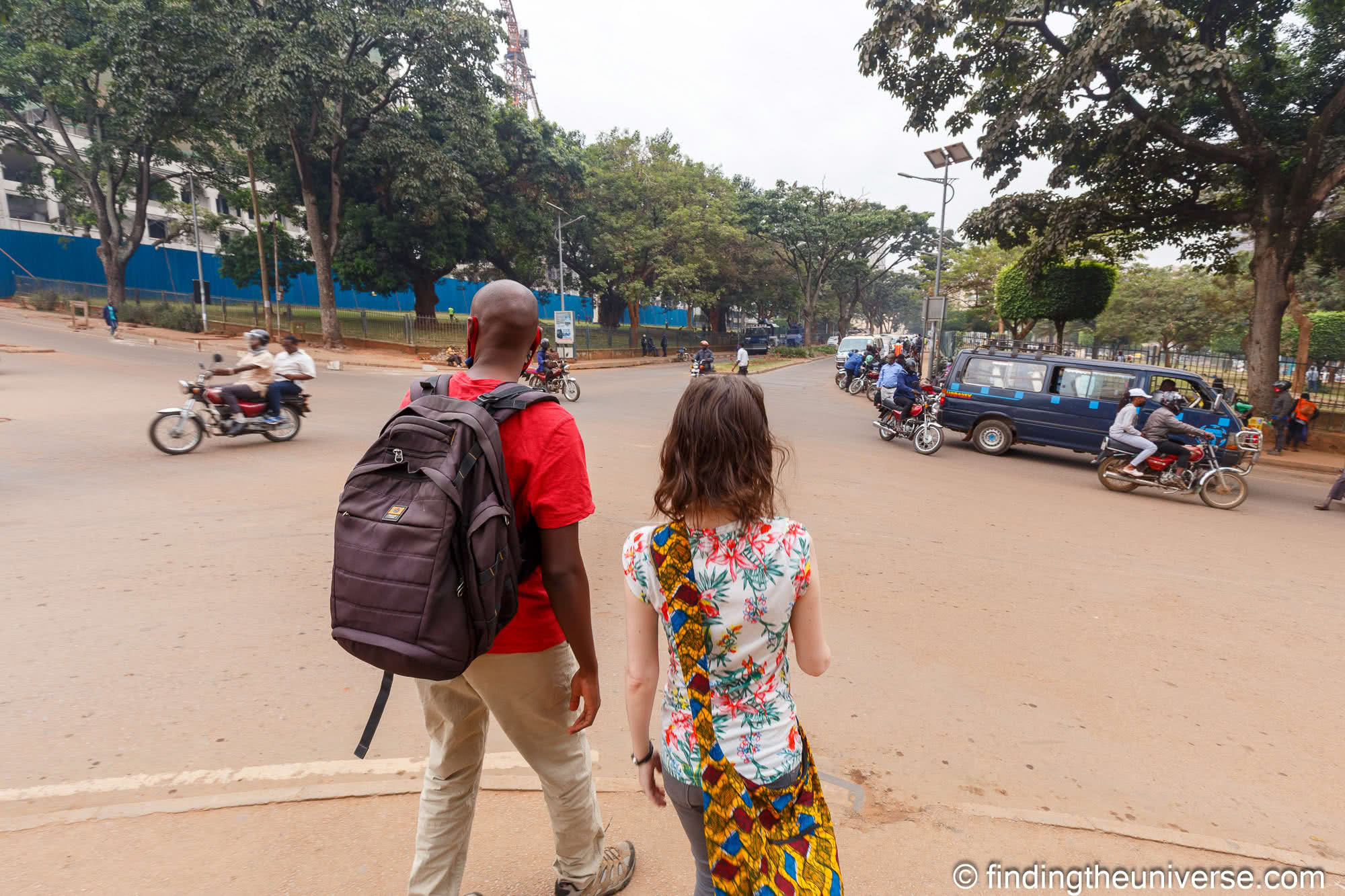

Getting Online in Uganda
You have a few options for getting online when you visit Uganda. First, many places including the majority of hotels have free WiFi, so you will be able to connect a smartphone, tablet, or laptop to WiFi. There is also often free WiFi at coffee shops and restaurants, especially those catering to tourists.
However, you are likely also going to want to be online even when not in range of a free WiFi hotspot. Most guides for example use WhatsApp for communication, which works over the internet. If you want to use a ride-sharing service like Uber you’ll also need to be able to get online.
So that means you’ll need a SIM card with data connectivty. We have used Airtel, and we bought a SIM card from the Airtel kiosk at the arrivals hall in the airport. There are a few different carriers, but Airtel worked well for us and was a good price. It also had the advantage that as we were visiting a few different East African countries we were able to purchase a roaming data bundle which covered us in Kenya, Rwanda and Tanzania as well.
Another option would be to use an eSIM service if your phone supports it. We’ve used Airalo in Uganda. We often use Airalo when we travel (see our full Airalo review here). It’s normally slightly more expensive than buying a local SIM, but will let you get online as soon as you land and skip having to find a SIM card and go through the local process of registering it.
If you want more advice on internet access when traveling, see our guide to getting online when traveling for some tips and advice.
Power Outlets / Travel Adapters for Uganda
Uganda uses a three-pin plug (Type G plug), as you will find in the UK and a number of other countries in East Africa. If you are coming from the UK or other country that uses the British plug, then your equipment will be fine and you shouldn’t need a travel adapter.
If you are visiting from a different country, such as from the USA, Canada, or most of Europe, then you will need a travel adaptor like this.
Additionally, Uganda uses a 220v-240v system. This is similar to much of the world with the exception of parts of the Americas, including Canada and the USA, where 110v is the norm. If you are travelling from one of these countries, you will need to check if your equipment supports the higher voltage. It should be written on the plug.
Generally, lower powered devices like cameras, laptops, and phone chargers support 110v – 240v, whilst higher power devices like hairdryers do not. See our guide to travel adapters for more on this topic.
Further Reading
That sums up our guide to things to do in Kampala. We hope you found it useful! Before you head off, we wanted to share some links to other content we think you might find useful in planning your trip to Uganda and the wider region.
- We have a detailed guide to things to do in Entebbe, to help you plan more of your trip.
- We have a detailed guide to chimpanzee trekking in Uganda as well as gorilla trekking in Uganda. These are both popular activities for visitors to Uganda and well worth doing in our opinion
- We have a guide to choosing the best safari camera, and a guide to getting better photos on safari, so you can ensure you get great memories of your trip.
- We also have a detailed safari packing list to help you decide what to bring with you
- If you are planning on visiting Kenya, check out our guide to things to do in Nairobi and our suggested 1 day Nairobi itinerary, which has lots of ideas for the city
- We have a guide to getting online when travelling, to help you stay connected in Uganda
- You’re going to need to power all your devices when you travel – see our guide to the best travel adapters so you can choose the right one for Uganda
- If you’d like a travel guide, consider the Uganda Bradt Travel Guide, which is generally regarded as the best option for Uganda. We’ve used the past edition and can highly recommend this book as it has everything from the history of the country and it’s people, through to packing tips, planning advice and more. It also includes detailed information on chimp and gorilla trekking.
- Book wise, we also pack and travel with both the Pocket Guide: Birds of East Africa and the Pocket Guide to the Mammals of East Africa. These are both very conveniently sized and will let you identify a lot of what you see on a visit to any east African country.
And that’s it! As always, we hope you found this guide useful. If you have any questions or comments, just pop them in the comments section below and we’ll get back to you as soon as we can.
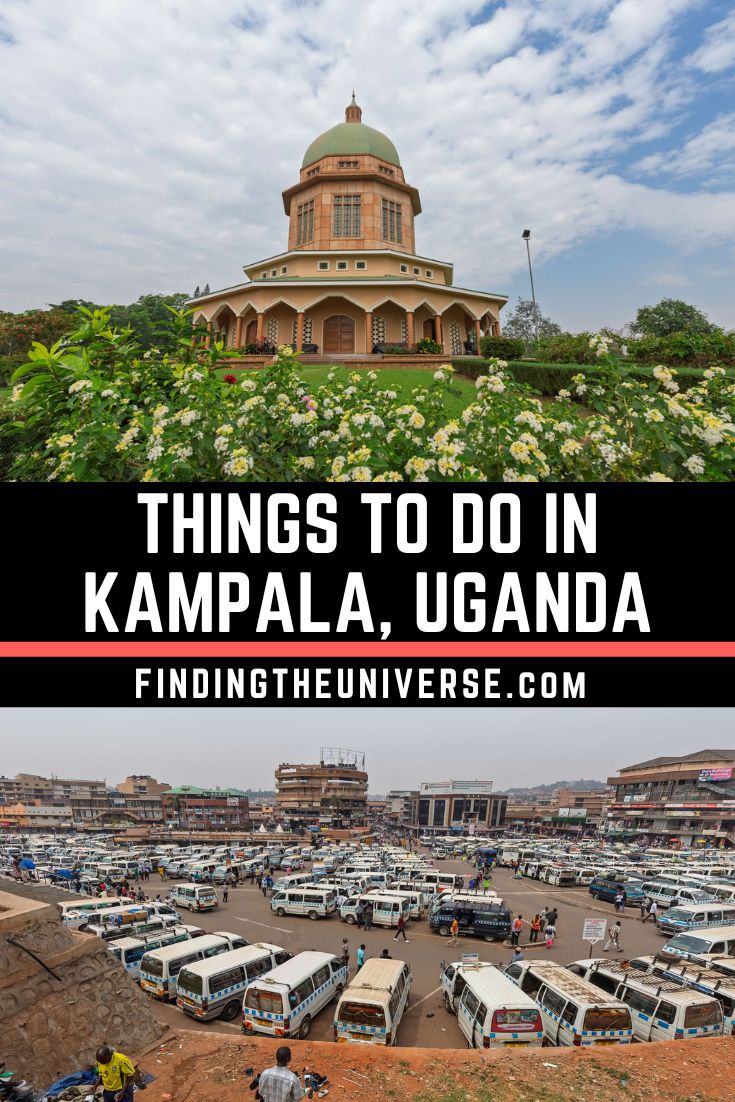

Източник за тази статия
Наши спонсори са:
Български трактори на добри цени при изключително качество





